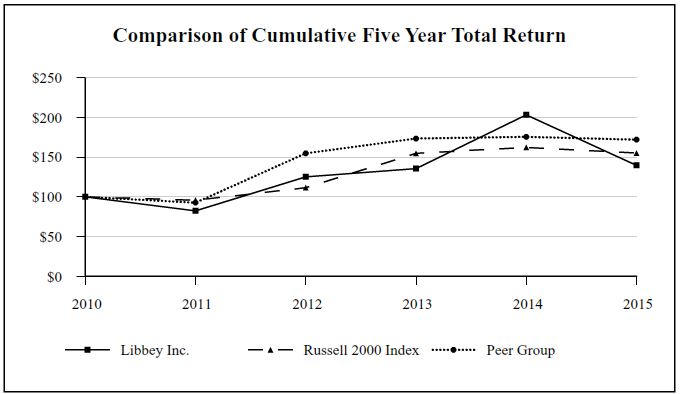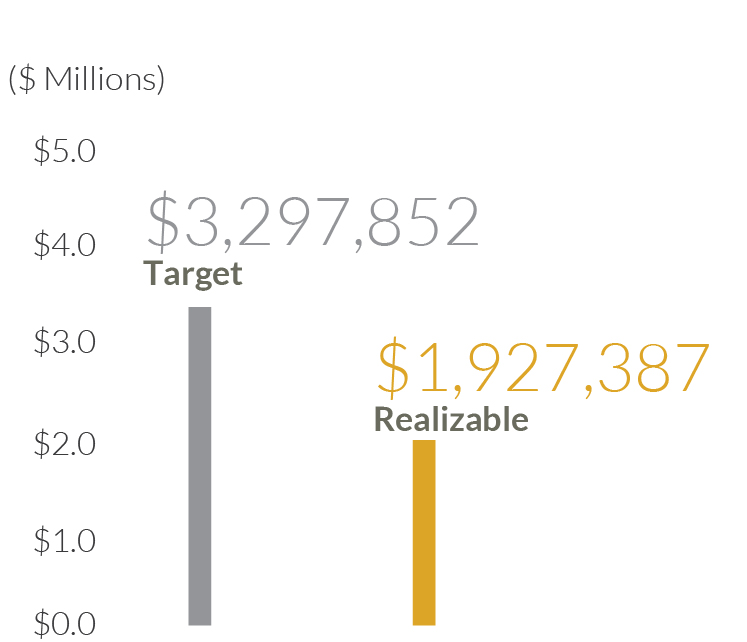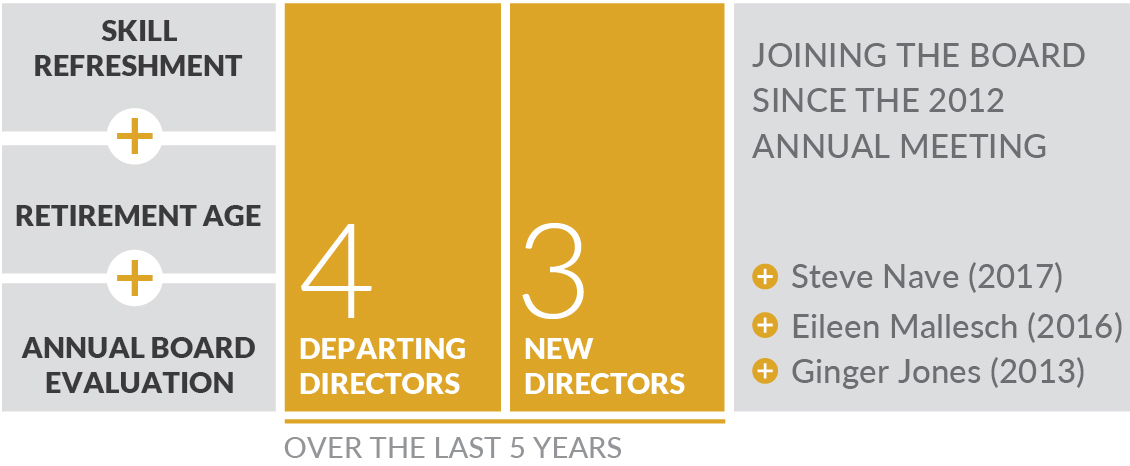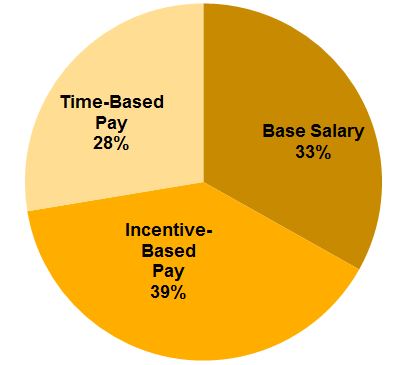|
| |
COMPENSATION-RELATEDBased on this information for 2017, the ratio of the annual total compensation of Mr. Foley, our CEO, to the median of the annual total compensation of all employees was: | 175: 1 |
To identify the median of the annual total compensation of all our employees, as well as to determine the annual total compensation of our median employee and our CEO, the methodology and the material assumptions, adjustments, and estimates that we used were as follows:
We selected October 1, 2017, as the date upon which we would identify the “median employee.”
We determined that, as of October 1, 2017, our employee population consisted of approximately 6,147 individuals. However, we chose to exclude the approximately six employees employed in Canada, two employees employed in Australia, and one employee employed in Singapore from the determination of the “median employee,” given the small number of employees in those jurisdictions and the estimated costs of obtaining their compensation information. In total, we excluded less than 5% of our non-U.S. workforce (approximately nine individuals) from the identification of the median employee, as permitted by SEC rules. After taking these exclusions into consideration, our employee population consisted of approximately 6,138 individuals.
Given the global distribution of our employee population, we use a variety of pay elements to structure the compensation arrangements of our employees. Consequently, for purposes of measuring the compensation of our employees, we selected “regular wages” as the most appropriate measure of compensation. “Regular wages” includes base wages, overtime, paid days off, shift differential, production schedule premium, production bonuses and non-US pay types such as Christmas bonus, anniversary bonus, and perfect attendance bonus. Given our multiple payroll systems, we gathered the requisite information applying this compensation measure with respect to our employees using the 12-month period ending December 31, 2017.
We did not make any cost-of-living adjustments in identifying the “median employee.”
Using this methodology, we determined that the “median employee” was a full-time, hourly employee located in Mexico, with regular wages of $11,061 for the 12-month period ending December 31, 2017. For purposes of translating to U.S. dollars the compensation elements paid in Mexican pesos, we used a year-end average rate comprised of the average month-end rate for the 12 calendar months.
With respect to the annual total compensation of the “median employee,” we identified and calculated the elements of the employee’s compensation for 2017 in accordance with the requirements of Item 402(c)(2)(x) of Regulation S-K, resulting in annual total compensation of $14,106. The difference between the employee’s regular wages and annual total compensation represents the estimated value of the employee’s other statutory benefits, ancillary benefits customary in Mexico, and pension benefits ($3,045).
| |
| • | With respect to the annual total compensation of our CEO, we used the amount reported in the “Total” column of our 2017 Summary Compensation Table included in this Proxy Statement. |
The Securities and Exchange Commission rules for identifying the median compensated employee and calculating the pay ratio based on that employee's annual total compensation allow companies to adopt a variety of methodologies, to apply certain exclusions and to make reasonable estimates and assumptions that reflect their compensation practices. As such, the pay ratio reported by other companies may not be comparable to the pay ratio reported above, as other companies may have different employment and compensation practices and may utilize different methodologies, exclusions, estimates and assumptions in calculating their own pay ratios.
AUDIT-RELATED MATTERS
|
| |
| PROPOSAL NO. 3 | |
| RATIFICATION OF AUDITORS | |
| The Audit Committee has appointed Deloitte & Touche LLP to serve as our independent auditors for our 2018 fiscal year. Although ratification by the shareholders is not required by law, the Board of Directors believes that you should be given the opportunity to express your views on the subject. Unless otherwise directed, proxies will be voted for ratification. | |
The Board of Directors recommends a vote FOR this proposal. |
Non-Management Directors’ CompensationWHAT FEES DID LIBBEY PAY TO ITS AUDITORS FOR FISCAL 2017 AND 2016?
For the years ended December 31, 2017, and December 31, 2016, Deloitte & Touche LLP served as the Company’s external auditors. Fees for services rendered by Deloitte & Touche LLP for the years ended December 31, 2017, and December 31, 2016, are as follows:
|
| | | | |
| Nature of Fees | | 2017 Fees ($) | | 2016 Fees ($) |
Audit Fees(1) | | 1,078,000 | | 1,116,444 |
Audit-Related Fees(2) | | 125,500 | | 112,840 |
| Tax Fees | | 0 | | 0 |
| All Other Fees | | 0 | | 0 |
| Total | | 1,203,500 | | 1,229,284 |
| |
| (1) | Audit Fees include fees associated with the annual audit of our internal controls, the annual audit of financial statements, the reviews of our quarterly reports on Form 10-Q and annual report on Form 10-K and statutory audit procedures. |
| |
| (2) | Audit-related fees include fees for audits of our employee benefit plans. |
WHAT ARE LIBBEY'S PRE-APPROVAL POLICIES AND PROCEDURES?
All audit-related, tax and other services were pre-approved by the Audit Committee, which concluded that the provision of these services by Deloitte & Touche LLP was compatible with the maintenance of that firm’s independence in 2015the conduct of its audit functions. The Audit Committee’s policy regarding auditor independence requires pre-approval by the Audit Committee of audit, audit-related and tax services on an annual basis. The policy requires that engagements that the auditors or management anticipates will exceed pre-established thresholds must be separately approved. The policy also provides that the Committee will authorize one of its members to pre-approve certain services. The Committee appointed Ginger Jones, Chair of the Committee, to pre-approve these services.
Our management directors doFor our 2017 fiscal year, Deloitte & Touche LLP served as the Company’s independent registered public accounting firm. The Audit Committee has appointed Deloitte & Touche LLP to serve as our independent auditors for our 2018 fiscal year.
Representatives of Deloitte & Touche LLP are expected to attend the Annual Meeting and will have an opportunity to make a statement if they so desire. The representatives will be available to respond to appropriate questions.
|
|
| Report of the Audit Committee |
The following Report of the Audit Committee does not receive additional pay for serviceconstitute soliciting material and should not be deemed filed or incorporated by reference into any other filing by Libbey under the Securities Act of 1933 or the Securities Exchange Act of 1934, except to the extent Libbey specifically incorporates this Report by reference therein.
The Audit Committee oversees the integrity of our financial statements on behalf of the Board of Directors. Directors; the adequacy of our systems of internal controls; our compliance with legal and regulatory requirements; the qualifications and independence of our independent auditors; and the performance of our independent auditors and of our internal audit function.
In fulfilling its oversight responsibilities, the Audit Committee has direct responsibility for, among other things:
confirming the independence of our independent auditors;
appointing, compensating and retaining our independent auditors;
reviewing the scope of the audit services to be provided by our independent auditors, including the adequacy of staffing and compensation;
approving non-audit services;
overseeing management’s relationship with our independent auditors;
overseeing management’s implementation and maintenance of effective systems of internal and disclosure controls;
reviewing our internal audit program; and
together with the Board and its other standing committees, overseeing our enterprise risk management program.
The Audit Committee reviews and discusses with management and the independent auditors all annual and quarterly financial statements before their issuance. The Audit Committee’s discussions with management and the independent auditors include a discussion of the quality, not just the acceptability, of the accounting principles, the reasonableness of significant judgments, and the clarity of disclosures in the financial statements.
With respect to the audited financial statements for the year ended December 31, 2017, the Audit Committee met both with management and with the independent auditors who are responsible for auditing the financial statements prepared by management and expressing an opinion on the conformity of those audited financial statements with accounting principles generally accepted in the United States. The Audit Committee also met with each of the independent auditors and the internal auditors without management being present. The Audit Committee discussed with the independent auditors and management the results of the independent auditors’ examinations; their judgments as to the quality, not just the acceptability, of our accounting principles; the adequacy and effectiveness of our accounting and financial internal controls; the reasonableness of significant judgments; the clarity of disclosures in the financial statements; and such other matters as are required to be communicated to the Audit Committee under Statement on Auditing Standards Standard No. 61, as amended, as adopted by the Public Company Accounting Oversight Board in Rule 3200T. The independent auditors provided the Audit Committee with the written disclosures and the letter required by applicable requirements of the Public Accounting Oversight Board regarding the independent auditors’ communications with the Audit Committee concerning independence, and the Audit Committee has discussed with the independent auditors their independence.
Taking all of these reviews and discussions into account, the Audit Committee has recommended to the Board of Directors that the audited financial statements be included in our Annual Report on Form 10-K for the year ended December 31, 2017, for filing with the Securities and Exchange Commission.
|
|
Ginger M. Jones, Chair |
| Eileen A. Mallesch |
| Deborah G. Miller |
| John C. Orr |
STOCK OWNERSHIP INFORMATION
WHO ARE THE LARGEST OWNERS OF LIBBEY STOCK?
The following table shows information with respect to the amounts payable,persons we know to be beneficial owners of more than 5% of our common stock as of December 31, 2017, based solely on an annualized basis, underfilings made by such beneficial owners with the SEC:
|
| | | | | |
| Name and Address of Beneficial Owner | | Amount and Nature of
Beneficial Ownership | | Percent of Class |
|
Frontier Capital Management Co., LLC.(1)
99 Summer Street
Boston, MA 02110 | | 1,850,495 | | 8.4 | % |
Dimensional Fund Advisors LP(2)
Building One
6300 Bee Cave Road
Austin, TX 78746 | | 1,545,708 | | 7.0 | % |
BlackRock, Inc.(3)
55 East 52nd Street
New York, NY 10055 | | 1,260,279 | | 5.7 | % |
| |
| (1) | Amendment No. 1 to Schedule 13G filed with the SEC on behalf of Frontier Capital Management Co., LLC. (“Frontier”), an investment adviser, indicates that, as of December 31, 2017, Frontier was the beneficial owner of 1,850,495 common shares, with sole dispositive power as to all of such shares, shared dispositive power as to none of such shares, sole voting power as to 746,156 common shares, and shared voting power with respect to no common shares. |
| |
| (2) | Amendment No. 3 to Schedule 13G filed with the SEC on behalf of Dimensional Fund Advisors LP (“Dimensional”), an investment adviser, indicates that, as of December 31, 2017, Dimensional was the beneficial owner of 1,545,708 common shares, with sole dispositive power as to all of such shares, shared dispositive power as to none of such shares, sole voting power with respect to 1,469,337 common shares, and shared voting power with respect to no common shares. |
| |
| (3) | Amendment No. 1 to Schedule 13G filed with the SEC on behalf of BlackRock, Inc. (“BlackRock”), a parent holding company, indicates that, as of December 31, 2017, BlackRock was the beneficial owner of 1,260,279 common shares, with sole dispositive power as to all of such shares, shared dispositive power as to none of such shares, sole voting power with respect to 1,229,645 common shares, and shared voting power with respect to no common shares. |
Stock Ownership Information
HOW MUCH LIBBEY STOCK DO OUR DIRECTORS AND OFFICERS OWN?
STOCK OWNERSHIP/RETENTION GUIDELINES
Non-Management Director Stock Ownership and Retention Guidelines
In July 2017, we adopted new stock ownership and retention guidelines for our non-management directors. These new guidelines replaced the stock retention guidelines that had been in place since 2015. The new guidelines were adopted based on review of a benchmarking study conducted by management at the request of the Nominating and Governance Committee. The Nominating and Governance Committee adopted the new guidelines in order to align with majority practice at companies with revenues between $500 million and $1 billion.
Under the new guidelines:
Each non-management director pay programwho joins the Board on or before August 1, 2017, must acquire, within five years from the date he or she was first elected to the Board, the number of shares of Libbey common stock determined by dividing $237,500 by the average closing price of Libbey common stock over the one-year period ending July 25, 2017.
Each non-management director who joined the Board after August 1, 2017, must acquire, within five years from the date on which he or she is first elected to the Board, the number of shares of Libbey common stock equal in value to at least five times the annual cash retainer for 2015:non-management directors in effect on the date the director is first elected to the Board. For purposes of determining the number of shares of Libbey common stock to be acquired, the cash equivalent value will be divided by the average closing price of Libbey common stock over the one-year period ending on the date of the director's election to the Board.
Until the director acquires the guideline number of shares, he or she must hold 100% of the net after-tax shares of Libbey common stock issued to him or her on the date of each annual shareholders meeting and all other Libbey shares that he or she owns or otherwise acquires.
Once the director has achieved the guideline number of shares, he or she may dispose of Libbey common stock subject, provided that: (a) until retirement, the director must continuously hold at least the guideline number of shares; and (2) shares of Libbey common stock purchased by the director and net after-tax shares issued to the director on the date of each annual shareholders meeting must be held by the director for at least one year from the date on which the director acquired them.
As of March 19, 2018, all of our existing non-management directors are in compliance with the Director Retention Guidelines.
Executive Stock Ownership/Retention Guidelines
In October 2007, we established guidelines pursuant to which our executive officers also are required to achieve ownership of meaningful amounts of equity in Libbey. We refer to the guidelines, as originally established, as the Original Guidelines.
Under the Original Guidelines, each executive officer was required to own a specified number of shares of Libbey common stock equal to a multiple of his or her base salary in effect on January 1, 2008, or, if later, the date on which the executive officer became subject to the guidelines. Ms. Kovach is the only executive officer who remained subject to the Original Guidelines as of December 31, 2017. As of December 31, 2017, she was in compliance with the Original Guidelines.
In late 2012, we transitioned our executive stock ownership guidelines to stock retention guidelines to provide greater parity between long-time executive officers and our newer executive officers and to further align our executives’ interests with those of shareholders. We refer to the new stock retention guidelines as the Executive Retention Guidelines.
Under the Executive Retention Guidelines, each executive is generally required to retain, until his or her separation from service:
50% of the net after-tax shares underlying each grant of RSUs made after January 1, 2013, that subsequently vests; and
50% of the net after-tax shares underlying NQSOs granted after January 1, 2013, that the executive subsequently exercises.
Ms. Kovach was exempt from the Executive Retention Guidelines until January 1, 2018. Until then, she could sell or otherwise dispose of our stock, but only to the extent of any shares in excess of her ownership guideline under the Original Guidelines.
Executives nearing retirement are released from our guidelines on the date the Board is notified of the planned retirement, or one year before the contemplated retirement date, whichever is later.
As of December 31, 2017, all applicable named executives were in compliance with the Executive Retention Guidelines.
Stock Ownership Information
BENEFICIAL OWNERSHIP TABLE
The following table shows, as of March 19, 2018, the number of shares of our common stock and percentage of all issued and outstanding shares of our common stock that are beneficially owned by our directors, the named executives and our directors and executive officers as a group. With respect to those named executives who were no longer employed by the Company as of March 19, 2018, the information included in this table is accurate to the best of our knowledge. Our address, as set forth on the Notice of Annual Meeting of Shareholders, is the address of each director and named executive set forth below. The shares owned by the named executives set forth below include the shares held in their accounts in our 401(k) plan. An asterisk indicates ownership of less than one percent of the outstanding stock.
|
| | | | | |
| Name of Beneficial Owner | | Amount and Nature of
Beneficial Ownership | | Percent of Class |
|
James C. Burmeister(1)(2)(4) | | 10,297 | | * |
|
Annunciata (Nucci) Cerioli(1)(2) | | 10,797 | | * |
|
Carlos V. Duno(3) | | 49,305 | | * |
|
William A. Foley(1)(2)(3) | | 166,220 | | * |
|
Ginger M. Jones(3) | | 17,397 | | * |
|
Susan A. Kovach(1)(2) | | 74,985 | | * |
|
Eileen A. Mallesch(3) | | 10,472 | | * |
|
Deborah G. Miller(3) | | 35,344 | | * |
|
Salvador Miñarro Villalobos(1)(2) | | 114,645 | | * |
|
Carol B. Moerdyk(3) | | 45,484 | | * |
|
Steve Nave(3) | | 0 | | * |
|
John C. Orr(3) | | 34,940 | | * |
|
Veronica (Ronni) L. Smith(1)(2)(4) | | 17,550 | | * |
|
Carol Summersgill(1)(2)(4) | | 3,079 | | * |
|
Directors and Executive Officers as a Group(1)(2)(3)(4) | | 590,515 | | 2.68 | % |
| |
| (1) | Does not include shares of our common stock that have vested but are deferred under our Executive Deferred Compensation Plan, which we refer to as our EDCP. As of March 19, 2018, each of our named executives, and all executive officers as a group, had the following number of shares of our common stock that are vested but deferred under our EDCP: |
|
| | |
| Named Executive | | Number of Deferred Shares |
| W. Foley | | 0 |
| J. Burmeister | | 0 |
| V. Smith | | 0 |
| A. Cerioli | | 0 |
| S. Kovach | | 17,720 |
| S. Miñarro | | 0 |
| C. Summersgill | | 0 |
| All executive officers as a group | | 17,720 |
Does not include the following number of shares of phantom stock that are held by our named executives and all executive officers as a group pursuant to our EDCP and that are payable in cash:
|
| | |
Annual Cash RetainerNamed Executive | | $47,500Number of Phantom Shares |
Chairman of the Board Cash RetainerW. Foley | | $80,0000 |
Equity AwardJ. Burmeister | | On the date of each annual meeting of shareholders, outright grant of shares of common stock valued at $80,000 on the date of grant0 |
Audit Committee Chair Cash RetainerV. Smith | | $12,500 per year, in addition to Audit Committee Member Retainer0 |
Compensation Committee Chair Cash RetainerA. Cerioli | | $12,500 per year, in addition to Compensation Committee Member Retainer0 |
Nominating and Governance Committee Chair Cash RetainerS. Kovach | | $6,500 per year, in addition to Nominating and Governance Committee Member Retainer1,014 |
Audit Committee Member Cash RetainerS. Miñarro | | $7,5000 |
Compensation Committee Member Cash RetainerC. Summersgill | | $7,5000 |
Nominating and Governance Committee Member Cash RetainerAll executive officers as a group | | $5,000 |
Other Fees | | $500 per one-half day of service1,014 |
Effective January 12, 2016, we combined the roles of Chairman of the Board and Chief Executive Officer and appointed a Lead Independent Director. Accordingly, the Chairman of the Board Cash Retainer was discontinued and replaced with a Lead Independent Director Cash Retainer of $20,000 per year.
We also maintain retention guidelines for non-management directors. For more information with respect to our stock retention guidelines for non-management directors, see2018 Proxy Statement ‘‘61
Stock Ownership — How much Libbey stock do our directors and officers own? — Stock Ownership Guidelines’’ above.
Directors may elect, pursuant to the Director DCP, to defer cash and/or equity compensation into any of 13 measurement funds. The Director DCP, as well as the predecessor deferred compensation plans under which non-management directors were eligible to participate, are unfunded plans, and the Company does not guarantee an above-market return on amounts deferred under any of these plans. Amounts deferred under the Director DCP, as well as under a predecessor plan, are, at the election of the applicable director, payable either in a lump sum or in installments over a period of time selected by the director. Amounts deferred under our first deferred compensation plan for outside directors are payable in a lump sum upon retirement from our Board or, if earlier, upon death of the director.
In addition to paying the compensation listed above, we reimburse our non-management directors for their travel expenses incurred in attending meetings of the Board or its committees, as well as for fees and expenses incurred in attending director education seminars and conferences. The directors do not receive any other personal benefits.
| |
| (2) | Includes the following number of NQSOs that have been granted to our named executives and all executive officers as a group and that currently are exercisable or will be exercisable on or before May 18, 2018: |
|
| | |
| Named Executive | | COMPENSATION-RELATED MATTERSNumber of Outstanding Stock Options
Exercisable Within 60 Days |
| W. Foley | | 85,437 |
| J. Burmeister | | 5,297 |
| V. Smith | | 15,350 |
| A. Cerioli | | 0 |
| S. Kovach | | 36,172 |
| S. Miñarro | | 81,428 |
| C. Summersgill | | 0 |
| All executive officers as a group | | 223,684 |
In 2015, our non-management directors received the following pay:
DIRECTOR COMPENSATION FOR YEAR ENDED DECEMBER 31, 2015
| |
| (3) | Includes the following number of shares of our common stock that are deferred by non-management directors under our 2009 Director Deferred Compensation Plan, which we refer to as our Director DCP, and that are payable as shares of our common stock: |
|
| | | | | | | | | | | | | |
| Director | | Fees Earned or Paid in Cash ($)(1) | | Stock Awards ($)(2) | | Change in Pension Value and Nonqualified Deferred Compensation Earnings ($)(3) | | All Other Compensation ($) | | Total ($) |
| Carlos V. Duno | | 72,500 |
| | 80,019 |
| | 0 | | 0 | | 152,519 |
|
| William A. Foley | | 140,000 |
| | 80,019 |
| | 0 | | 0 | | 220,019 |
|
| Peter C. McC. Howell | | 60,000 |
| | 80,019 |
| | 0 | | 0 | | 140,019 |
|
| Ginger M. Jones | | 75,000 |
| | 80,019 |
| | 0 | | 0 | | 155,019 |
|
| Theo Killion | | 55,000 |
| | 80,019 |
| | 0 | | 0 | | 135,019 |
|
| Deborah G. Miller | | 62,500 |
| | 80,019 |
| | 0 | | 0 | | 142,519 |
|
| Carol B. Moerdyk | | 60,000 |
| | 80,019 |
| | 0 | | 0 | | 140,019 |
|
| John C. Orr | | 66,500 |
| | 80,019 |
| | 0 | | 0 | | 146,519 |
|
|
| | |
| Name of Director | | Number of Deferred Shares |
| C. Duno | | 26,327 |
W. Foley(a) | | 0 |
| G. Jones | | 0 |
| E. Mallesch | | 10,472 |
| D. Miller | | 0 |
| C. Moerdyk | | 0 |
| S. Nave | | 0 |
| J. Orr | | 0 |
| All non-management directors as a group | | 36,799 |
Does not include the following number of shares of phantom stock that are held by non-management directors pursuant to our deferred compensation plans for outside directors and that are payable in cash:
|
| | |
| Name of Director | | Number of Phantom Shares |
| C. Duno | | 0 |
W. Foley(a) | | 13,126 |
| G. Jones | | 0 |
| E. Mallesch | | 0 |
| D. Miller | | 2,443 |
| C. Moerdyk | | 20,566 |
| S. Nave | | 6,921 |
| J. Orr | | 0 |
| All non-management directors as a group | | 43,056 |
| |
| (a) | Mr. Foley was a non-management director from 1994 until he assumed the role of CEO on January 12, 2016. |
| |
| (4) | Based on last known information as of date of separation from service. For Ms. Cerioli, that date was March 31, 2017. For Mr. Miñarro, that date was January 15, 2018. For Ms. Smith, that date was December 31, 2017. For Ms. Summersgill, that date was February 23, 2018. |
Stock Ownership Information
In addition to outstanding shares of common stock that our named executives beneficially owned as of March 19, 2018, or, for those no longer employed by the Company as of that date, as of their last date of employment, the named executives and all executive officers as a group have received the following grants of RSUs that have not yet vested:
|
| | |
| Named Executive | | Number of Unvested RSUs(1) |
| W. Foley | | 222,438 |
| J. Burmeister | | 33,538 |
| V. Smith | | 0 |
| A. Cerioli | | 0 |
| S. Kovach | | 30,727 |
| S. Minarro | | 0 |
| C. Summersgill | | 0 |
| All executive officers as a group | | 342,773 |
| |
| (1) | Includes pay deferred into the LibbeyOf these amounts, a total of 867 RSUs with four-year ratable vesting were awarded on February 16, 2015; a total of 33,792 RSUs with four-year ratable vesting were awarded on February 8, 2016; a total of 37,160 RSUs with four-year ratable vesting were awarded on February 6, 2017; a total of 9,344 RSUs with four-year ratable vesting were awarded on March 16, 2017; a total of 15,877 RSUs with four-year ratable vesting were awarded on October 23, 2017; a total of 14,000 RSUs with three-year cliff vesting were awarded on November 3, 2017; and a total of 231,733 RSUs with four-year ratable vesting were awarded on February 5, 2018. One share of our common stock measurement fund pursuant towill be issued for each vested RSU. Dividends do not accrue on RSUs until they vest. For further information, see “Executive Compensation — Compensation Discussion and Analysis — What pay did Libbey's executives receive for 2017?”and the Director DCP.Outstanding Equity Awards at Fiscal Year-End Table above. |
|
|
| Section 16(a) Beneficial Ownership Reporting Compliance |
All of our directors and executive officers are required to file initial reports of share ownership and reports of changes in ownership with the SEC pursuant to Section 16(a) of the Exchange Act. We have reviewed these reports, including any amendments, and written representations from the executive officers and directors of the Company. Based solely on this review, we believe that all 2017 filing requirements were met for each of our directors and executive officers subject to Section 16(a), with the following exceptions: one inadvertently late filing for Mr. Nave regarding one transaction in 2017 related to deferred director cash compensation; and one inadvertently late filing for Ms. Kovach regarding nine transactions that occurred from 2009 through 2011 related to deferred executive cash compensation.
QUESTIONS AND ANSWERS ABOUT
THE MEETING
WHO MAY VOTE?
You may vote if you were a holder of the common stock of Libbey Inc. at the close of business on March 19, 2018.
A complete list of shareholders entitled to vote at the Annual Meeting will be maintained at the Company’s principal executive offices at 300 Madison Avenue, Toledo, Ohio, for a period of at least 10 days before the Annual Meeting.
WHAT MAY I VOTE ON, WHAT ARE MY VOTING OPTIONS AND HOW DOES THE BOARD RECOMMEND THAT I VOTE?
|
| | | | | |
(2)Proposal | Represents | Voting Options | | Board Recommendation |
| 1 | Election of Directors:
Election of Carol B. Moerdyk and John C. Orr to serve as
Class I directors | | For, Withhold (as to any
nominee) or Abstain | | FOReach of
Ms. Moerdyk
and Mr. Orr |
| 2 | Advisory Say-on-Pay:
RESOLVED, that the grant date fair value, determined in accordance with FASB ASC Topic 718, of awards of stock made to non-management directors on May 12, 2015. On that date, we awarded certain non-management directors stock having a grant date fair value of $40.66 per share. Mr. Howell elected to defer receipt of a portionstockholders of the stockCompany approve,
on an advisory and non-binding basis, the compensation of
the Company’s named executives, as disclosed in this proxy statement, including the Compensation Discussion and Analysis, compensation tables and narrative discussion, pursuant to
Item 402 of Regulation S-K | | For, Against or Abstain | | FOR |
| 3 | Ratification of Independent Auditor:
Ratification of the Director DCP.appointment of Deloitte & Touche LLP as Libbey’s independent auditors for the 2018 fiscal year | | For, Against or Abstain | | FOR |
HOW DO I VOTE?
Registered Shareholders
If you are a registered shareholder, you may vote in any of the following ways:
|
| | |
(3) | We do not maintain | Vote by telephone: Call on a pension plan for our non-management directors. We do not guarantee any particular rate of returntouch-tone telephone, toll-free 1-800-690-6903, 24 hours a day, seven days a week, until 11:59 p.m., eastern daylight saving time, on any pay deferred pursuantMay 15, 2018. Make sure you have your proxy card, notice document or email that you received and follow the simple instructions provided. |
| | Vote over the internet: Go to our deferred compensation plans. Dividendswww.proxyvote.com, 24 hours a day, seven days a week, until 11:59 p.m., eastern daylight saving time, on pay deferred intoMay 15, 2018. Make sure you have available the Libbey Inc. phantom stockproxy card, notice document or measurement fund under our deferred compensation plans for non-management directors accrue only ifemail that you received and tofollow the extent payable to holders of our common stock. Pay deferred into interest-bearing accounts under our deferred compensation plans for non-management directors does not earn an above-market return, as the applicable interest rate is the yield on ten-year treasuries. Pay deferred into other measurement funds under our deferred compensation plans for non-management directors does not earn an above-market return as that pay earns a return only if and to the extent that the net asset valuesimple instructions provided. |
| | Vote by mail: If you received printed copies of the measurement fund into whichproxy materials by mail, you may mark, date and sign the payenclosed proxy card and return it in the postage-paid envelope that was provided to you. You should sign your name exactly as it appears on the proxy card. If you are signing in a representative capacity (for example, as guardian, executor, trustee, custodian, attorney or officer of a corporation), you should indicate your name and title or capacity. |
| | Vote in person at the annual meeting: Bring the proxy card, notice document or email you received and bring other proof of identification and request a ballot at the meeting. |
Shares held jointly by two or more registered shareholders may be voted by any joint owner unless we receive written notice from another joint owner denying the authority of the first joint owner to vote those shares.
Questions and Answers About the Meeting
Shares Held in Street Name
If you hold your shares in street name — in other words, you hold your shares through a broker or other nominee — you will receive from your broker a notice regarding availability of proxy materials that will tell you how to access our proxy materials and provide voting instructions to your broker over the internet. It also will tell you how to request a paper or e-mail copy of our proxy materials. If you hold your shares in street name and do not provide voting instructions to your broker, your shares will not be voted on any proposals on which your broker does not have discretionary authority to vote, including Proposals 1 and 2.
Shares Held Through 401(k) Plan
If you participate in one of our 401(k) plans, and if you have investments in the Libbey Inc. stock fund and have an e-mail address provided by Libbey for business purposes, you will receive an e-mail message at your Libbey-provided e-mail address containing instructions that you must follow in order for shares in your account to be voted. If you participate in one of our 401(k) plans, have investments in the Libbey Inc. stock fund and do not have an e-mail address provided by Libbey for business purposes, you will receive instructions from the trustee of the applicable 401(k) plan that you must follow in order for shares in your account to be voted.
MAY I CHANGE MY VOTE?
If you are a shareholder of record, you may, at any time before your shares are voted at the annual meeting, change your vote or revoke your proxy by:
sending us a proxy card dated later than your last vote;
notifying the Secretary of Libbey in writing; or
voting at the meeting.
If you hold your shares in street name through a broker or other nominee, you should contact your broker or nominee to determine how to change your vote or revoke your proxy.
HOW MANY SHARES OF LIBBEY COMMON STOCK ARE OUTSTANDING?
At the close of business on March 19, 2018, there were 22,028,718 shares of Libbey common stock outstanding. Each share of common stock is entitled to one vote.
HOW BIG A VOTE DO THE PROPOSALS NEED IN ORDER TO BE ADOPTED?
Provided that a quorum is present either in person or by proxy at the Annual Meeting, Proposals 1 through 3 must receive the required votes set forth below:
|
| | | |
| Proposal | | Required Vote |
| 1 | Election of Carol B. Moerdyk and John C. Orr as Class I directors | | Since the election of directors is deemed invested actually increases.uncontested, each director must receive the vote of the majority of the votes cast with respect to such director’s election. |
| 2 | Advisory Say-on-Pay | | The affirmative vote of a majority of the shares present in person or represented by proxy at the meeting and entitled to vote on the proposal. |
| 3 | Ratification of Independent Auditors | | The affirmative vote of a majority of the shares present in person or represented by proxy at the meeting and entitled to vote on the proposal. |
WHAT CONSTITUTES A QUORUM?
Under our By-laws, the holders of a majority of the total shares issued and outstanding, whether present in person or represented by proxy, will constitute a quorum, permitting business to be transacted at the meeting.
HOW WILL VOTES BE COUNTED?
Votes cast in person or by proxy will be tabulated by the inspector of elections appointed for the meeting and will determine whether a quorum is present. Abstentions will be counted as shares that are present and entitled to vote for purposes of determining whether a quorum is present. For purposes of determining whether the shareholders have approved a matter, abstentions are not treated as votes cast “for,” “against” or “withheld,” and therefore will have no effect on the outcome of any of Proposals 1 – 3. Additionally, broker non-votes will not be considered as present and entitled to vote with respect to any of Proposals 1 – 2. The common stock outstanding on the record date held by the trustee under Libbey’s 401(k) plans will be voted by the trustee in accordance with instructions from participants in those plans. Votes will not be cast with respect to those shares in the plans for which no instructions are received.
Question and Answers About the Meeting
WHAT ARE BROKER NON-VOTES?
If you hold your shares in street name through a broker or other nominee, your broker or nominee may not be permitted to vote your shares with respect to certain matters, including Proposals 1 – 2, unless you give your broker or nominee specific instructions as to how to vote. Non-voted shares on non-routine matters are called broker non-votes. They will not be counted in determining the number of shares necessary for approval but will be counted in determining whether there is a quorum.
HOW WILL VOTING BE CONDUCTED ON OTHER MATTERS RAISED AT THE MEETING?
The proxy committee will vote on other matters that properly come before the meeting in accordance with the Board’s recommendation or, if no recommendation is given, in the discretion of the proxy committee.
WHEN MUST SHAREHOLDER PROPOSALS BE SUBMITTED FOR THE 2019 ANNUAL MEETING?
A shareholder desiring to submit a proposal for inclusion in our Proxy Statement for our 2019 Annual Meeting must deliver the proposal so that we receive it no later than November 29, 2018. Any proposal submitted outside the processes of Rule 14a-8 under the Exchange Act will be considered untimely if submitted after February 12, 2019. A shareholder desiring to nominate one or more directors for election at our 2019 Annual Meeting must deliver the written nomination no earlier than January 16, 2019, and no later than February 15, 2019. All such proposals must be addressed to Susan A. Kovach, Vice President, General Counsel and Secretary, Libbey Inc., 300 Madison Avenue, P.O. Box 10060, Toledo, Ohio 43699-0060.
GENERAL INFORMATION
|
|
| Certain Legal Proceedings |
We are notinvolved in various routine legal proceedings arising in the ordinary course of our business. In addition, the Company and its subsidiaries are subject to examination by various countries’ tax authorities. These examinations may lead to proposed or assessed adjustments to our taxes. For a partydetailed discussion on tax contingencies, see note 7, Income Taxes, to any litigation, the outcomeConsolidated Financial Statements included in Part II, Item 8 of which, if decided adversely to us, reasonably could be expected to have a material adverse effectthe Company’s Annual Report on Libbey.Form 10-K for the year ended December 31, 2017.
As of the date of this proxy statement, neither the Board nor management knows of any other business that will be presented for consideration at the Annual Meeting. However, if other proper matters are presented at the meeting, it is the intention of the proxy committee to take such action as shall be in accordance with their judgment on such matters. All other matters to be voted upon by shareholders will require a majority vote of common stock represented in person or by proxy.
|
| |
OTHER MATTERS | Solicitation Costs |
General Information
Availability of List of Shareholders:
A complete list of shareholders entitled to vote at the Annual Meeting will be maintained at the Company’s principal executive offices at 300 Madison Avenue, Toledo, Ohio for a period of at least 10 days prior to the Annual Meeting.
Solicitation Costs:
The Company has retained Georgeson Shareholder to solicit the submission of proxies authorizing the voting of shares in accordance with the Board’s recommendations. The Company has agreed to pay a fee of $8,000, plus expenses for out-of-pocket costs, for Georgeson’s services. Certain of the Company’s officers and employees may solicit the submission of proxies authorizing the voting of shares in accordance with the Board of Directors’ recommendations, but no additional remuneration will be paid by the Company for the solicitation of those proxies. Such solicitations may be made by personal interview, telephone or telegram. Arrangements have been made with Corporate Investor Communications, Inc. to perform a broker-nominee search. Arrangements also have been made with brokerage firms and others for the forwarding of proxy solicitation materials to the beneficial owners of common stock, and the Company will reimburse them for reasonable out-of-pocket expenses incurred in connection therewith. The Company will pay the cost of preparing and mailing this proxy statement and other costs of the proxy solicitation made by the Company’s Board of Directors.
We are pleased to take advantage of SEC rules that permit issuers to furnish their proxy materials to shareholders on the internet. Shareholders may request a paper copy of this proxy statement and the 20152017 Annual Report by:
|
| |
| Internet | www.proxyvote.com |
| Telephone | 1-800-579-1639 |
| Email | sendmaterial@proxyvote.com |
A copy of the Company’s Annual Report on Form 10-K for the year ended December 31, 2015,2017, including the consolidated financial statements, as filed with the Securities and Exchange Commission, may be obtained without charge by sending a written request to Libbey Inc., Attention: Investor Relations, 300 Madison Avenue, P.O. Box 10060, Toledo, Ohio 43699-0060.
By Order of the Board of Directors,


Susan A. Kovach
SecretarySUSAN A. KOVACH,
SecretaryToledo, Ohio
March 29, 2018
Toledo, Ohio
March 29, 2016
682018 Proxy Statement 67
APPENDIX A
Calculation of Adjusted Cash Earnings Used For Incentive Compensation Purposes
(dollars in thousands)
|
| | | | | |
| | | Year ended December 31, 2017 | |
Adjusted EBITDA(1) | | | | |
| Reported net income (loss) (U.S. GAAP) | | $ | (93,368 | ) | |
| Add: Interest expense | | | 20,400 |
| |
| Add: Provision for income taxes | | | 15,798 |
| |
| Add: Depreciation and amortization | | | 45,544 |
| |
| Add: Special items before interest and taxes | | | | |
| Goodwill impairment | | | 79,700 |
| |
| Reorganization/restructuring charges | | | 2,488 |
| |
| Reported Adjusted EBITDA (non-GAAP) | | | 70,562 |
| |
| Impact of currency to reflect results at budgeted exchange rates | | | (4,761 | ) | |
| Adjusted EBITDA at budgeted exchange rates (non-GAAP) | | $ | 65,801 |
| |
| | | | | |
Increase in Trade Working Capital(2) | | | | |
| Increase in accounts receivable - net | | $ | 4,884 |
| |
| Increase in inventories - net | | | 17,877 |
| |
| Increase in accounts payable | | | (6,764 | ) | |
| Increase in Trade Working Capital (non-GAAP) | | | 15,997 |
| |
| Increase due to currency | | | (9,597 | ) | |
| Increase in Trade Working Capital at budgeted exchange rates (non-GAAP) | | $ | 6,400 |
| |
| | | | | |
| Adjusted Cash Earnings | | | | |
| Adjusted EBITDA at budgeted exchange rates (non-GAAP) | | $ | 65,801 |
| |
| Increase in Trade Working Capital at budgeted exchange rates (non-GAAP) | | | (6,400 | ) | |
| Adjusted Cash Earnings at budgeted exchange rates (non-GAAP) | | $ | 59,401 |
| |
| |
| (1) | We believe that Adjusted EBITDA, a non-GAAP financial measure, is a useful metric for evaluating our financial performance, as it is a measure that we use internally to assess our performance. For certain limitations and a reconciliation from net income (loss) to Adjusted EBITDA, see the "Non-GAAP Measures" and "Reconciliation of Net Income (Loss) to Adjusted EBITDA" sections included in Part II, Item 6. Selected Financial Data, in our 2017 Annual Report on Form 10-K. |
| |
| (2) | Trade Working Capital, a non-GAAP financial measure, is defined as net accounts receivable plus net inventories less accounts payable. We believe that Trade Working Capital is important supplemental information for investors in evaluating liquidity in that it provides insight into the availability of net current resources to fund our ongoing operations. Trade Working Capital is a measure used by management in internal evaluations of cash availability and operational performance. |
Trade Working Capital is used in conjunction with and in addition to results presented in accordance with U.S. GAAP. Trade Working Capital is neither intended to represent nor be an alternative to any measure of liquidity and operational performance recorded under U.S. GAAP. Trade Working Capital may not be comparable to similarly titled measures reported by other companies.
Calculation of Return on Invested Capital (ROIC) Used For Incentive Compensation Purposes
|
| | | | | |
| | | Year ended December 31, 2017 |
| ROIC | | | | |
| Defined as: After tax adjusted income from operations (using a 35% tax rate) over ending Trade Working Capital (accounts receivable-net plus inventory-net, less accounts payable) plus net book value of property, plant and equipment | | | | |
| Reported income from operations | | $ | (53,655 | ) | |
| Add: Adjustments | | | | |
| Goodwill impairment | | | 79,700 |
| |
| Reorganization/restructuring charges | | | 2,488 |
| |
| Adjusted income from operations | | | 28,533 |
| |
| Add: Impact of currency to reflect results at budgeted exchange rates | | | (7,549 | ) | |
| Adjusted income from operations at budgeted exchange rates | | | 20,984 |
| |
| Factor to apply for taxes | | | 65 |
| % |
| After tax adjusted income from operations at budgeted exchange rates | | $ | 13,640 |
| |
| | | | | |
| Invested capital | | | | |
| Reported property, plant and equipment, net | | $ | 265,675 |
| |
| Add: Impact of currency to reflect results at budgeted exchange rates | | | (9,457 | ) | |
| Property, plant and equipment, net at budgeted exchange rates | | | 256,218 |
| |
| Accounts receivable - net | | | 89,997 |
| |
| Inventories - net | | | 187,886 |
| |
| Less: Accounts payable | | | 78,346 |
| |
| Reported Trade Working Capital (non-GAAP) | | | 199,537 |
| |
| Add: Impact of currency | | | 9,597 |
| |
| Trade Working Capital at budgeted exchange rates (non-GAAP) | | | 189,940 |
| |
| Total invested capital at budgeted exchange rates | | $ | 446,158 |
| |
| | | | | |
| ROIC | | | 3.1 |
| % |
|
| | |
| | |
| |
Article 1. Establishment, Purpose, and Duration | 3 |
|
Article 2. Definitions | 3 |
|
Article 3. Administration | 7 |
|
Article 4. Shares Subject to this Plan and Maximum Awards | 8 |
|
Article 5. Eligibility and Participation | 10 |
|
Article 6. Stock Options | 10 |
|
Article 7. Stock Appreciation Rights | 11 |
|
Article 8. Restricted Stock and Restricted Stock Units | 12 |
|
Article 9. Performance Units/Performance Shares | 13 |
|
Article 10. Cash-Based Awards and Other Stock-Based Awards | 14 |
|
Article 11. Transferability of Awards | 14 |
|
Article 12. Performance Measures | 15 |
|
Article 13. Non-employee Director Awards | 16 |
|
Article 14. Dividend Equivalents | 16 |
|
Article 15. Beneficiary Designation | 16 |
|
Article 16. Rights of Participants | 16 |
|
Article 17. Change of Control | 17 |
|
Article 18. Amendment, Modification, Suspension, and Termination | 18 |
|
Article 19. Withholding | 18 |
|
Article 20. Successors | 18 |
|
Article 21. General Provisions | 18 |
|
| |
Libbey Inc. 2016 Omnibus Incentive Plan
Article 1. Establishment, Purpose, and Duration
1.1Establishment. Libbey Inc., a Delaware corporation (the “Company”), establishes an incentive compensation plan to be known as the Libbey Inc. 2016 Omnibus Incentive Plan (the “Plan”), as set forth in this document.
This Plan permits the grant of Nonqualified Stock Options, Incentive Stock Options, Stock Appreciation Rights, Restricted Stock, Restricted Stock Units, Performance Shares, Performance Units, Cash-Based Awardsand Other Stock-Based Awards.
This Plan shall become effective upon shareholder approval (the “Effective Date”) and shall remain in effect as provided in Section 1.3 hereof.
1.2 Purpose of this Plan. The purpose of this Plan is to enable the Company to obtain and retain the services of Employees and Non-employee Directors considered essential to the long-range success of the Company, to provide a means whereby Employees and Non-employee Directors develop a sense of proprietorship and personal involvement in the development and financial success of the Company, and to encourage them to devote their best efforts to the business of the Company, thereby advancing the interests of the Company and its shareholders.
1.3Duration of this Plan. Unless sooner terminated as provided in this Plan, this Plan shall terminate ten (10) years from the Effective Date. After this Plan is terminated, no Awards may be granted, but Awards previously granted shall remain outstanding in accordance with their applicable terms and conditions and this Plan’s terms and conditions. Notwithstanding the foregoing, no Incentive Stock Options may be granted more than ten (10) years after the earlier of (a) adoption of this Plan by the Board or (b) the Effective Date.
Article 2. Definitions
Whenever used in this Plan, the following terms shall have the meanings set forth below, and when the meaning is intended, the initial letter of the word shall be capitalized.
| |
2.1 | “Affiliate” means any corporation or other entity (including, but not limited to, a partnership or a limited liability company) that is affiliated with the Company through stock or equity ownership, or otherwise, and is designated as an Affiliate for purposes of this Plan by the Committee. For purposes of granting Options or Stock Appreciation Rights, an entity may not be considered an Affiliate if it results in noncompliance with Code Section 409A.
|
| |
2.2 | “Annual Award Limit” or “Annual Award Limits” has the meaning set forth in Section 4.3.
|
| |
2.3 | “Award” means, individually or collectively, a grant under this Plan of Nonqualified Stock Options, Incentive Stock Options, SARs, Restricted Stock, Restricted Stock Units, Performance Shares, Performance Units, Cash-Based Awardsor Other Stock-Based Awards, in each case subject to the terms of this Plan.
|
| |
2.4 | “Award Agreement” or “Agreement” means either (i) a written agreement entered into by the Company and a Participant setting forth the terms and provisions applicable to an Award granted under this Plan or (ii) a written statement issued by the Company to a Participant describing the terms and provisions of the Award, including any amendment or modification thereof. The Committee may provide for the use of electronic, internet or other non-paper Award Agreements and the use of electronic, internet or other non-paper means for the acceptance of the Award Agreements and actions under them by a Participant.
|
| |
2.5 | “Beneficial Owner” or “Beneficial Ownership” has the meaning ascribed to that term in Rule 13d-3 of the General Rules and Regulations under the Exchange Act.
|
| |
2.6 | “Board” or “Board of Directors” means the Board of Directors of the Company.
|
| |
2.7 | “Cash-Based Award” means an Award, denominated in cash, granted to a Participant as described in Article 10.
|
| |
2.8 | “Change in Control” means any of the following events:
|
| |
(a) | Any Person (as defined below) is or becomes the Beneficial Owner, directly or indirectly, of securities of the Company representing thirty percent (30%) or more of the combined voting power of the Company’s then-outstanding securities. For purposes of this Plan, the term “Person” is used as that term is used in Sections 13(d) and 14(d) of the Exchange Act; provided, however, that the term shall not include (i) the Company, any trustee or other fiduciary holding securities under an employee benefit plan of the Company, or (ii) any corporation owned, directly or indirectly, by the shareholders of the Company in substantially the same proportions as their ownership of stock of the Company, and provided further that this subsection (a) shall not apply to any Person who is the Beneficial Owner, directly or indirectly, of securities of the Company representing twenty percent (20%) or more of the combined voting power of the Company’s then-outstanding securities as of the Effective Date of this Plan if and for so long as that Person does not beneficially own, or increase its beneficial ownership to, twenty-five percent (25%) or more of the combined voting power of the Company’s then-outstanding securities; |
| |
(b) | During any period of two (2) consecutive years beginning after the Effective Date of this Plan, Continuing Directors (excluding any Directors designated by a Person who has entered into an agreement with the Company to effect a transaction described in Sections 2.8(a), (c) or (d)) cease for any reason to constitute at least a majority of the Board; |
| |
(c) | The consummation of a merger or consolidation of the Company with any other corporation or other entity, unless, after giving effect to the merger or consolidation, the voting securities of the Company outstanding immediately prior to the merger or consolidation continue to represent (either by remaining outstanding or by being converted into voting securities of the surviving entity) more than sixty-six and two-thirds percent (66 2/3%) of the combined voting power of the voting securities of the Company or the surviving entity outstanding immediately after the merger or consolidation; or |
| |
(d) | Consummation of a plan of complete liquidation of the Company or an agreement for the sale or disposition by the Company of all or substantially all of the Company’s assets. |
| |
2.9 | “Code” means the U.S. Internal Revenue Code of 1986, as amended from time to time. For purposes of this Plan, references to sections of the Code shall be deemed to include references to any applicable regulations under the Code and any successor or similar provision.
|
| |
2.10 | “Committee” means the Compensation Committee of the Board or a subcommittee thereof, or any other committee designated by the Board to administer this Plan. The members of the Committee shall be appointed from time to time by, and shall serve at the discretion of, the Board. If the Committee does not exist or cannot function for any reason, the Board may take any action under the Plan that otherwise would be the responsibility of the Committee.
|
| |
2.11 | “Company” means Libbey Inc., a Delaware corporation, and any successor thereto as provided in Article 20.
|
| |
2.12 | “Continuing Directors” means individuals who both (a) as of the end of the period in question are Directors of the Company or whose election or nomination for election by the Company’s shareholders has been approved by a vote of at least two-thirds (2/3) of the Directors of the Company then in office and (b) either (i) at the beginning of the period in question or (ii) after the beginning but prior to the end of the period in question were Directors of the Company or whose election or
|
nomination for election by the Company’s shareholders was approved by a vote of at least two-thirds (2/3) of the Directors of the Company in office at the beginning of the period.
| |
2.13 | “Covered Employee” means any Employee who is or may become a “Covered Employee,” as defined in Code Section 162(m), and who is designated, either as an individual Employee or class of Employees, by the Committee within the shorter of (i) ninety (90) days after the beginning of the Performance Period or (ii) twenty-five percent (25%) of the Performance Period has elapsed, as a “Covered Employee” under this Plan for the applicable Performance Period.
|
| |
2.14 | “Director” means any individual who is a member of the Board of Directors of the Company.
|
| |
2.15 | “Dividend Equivalent” means a right to receive the equivalent value (in cash or Shares) of dividends paid on common stock, awarded under Article 14.
|
| |
2.16 | “DRO” means a domestic relations order as defined by the Code or Title I of the Employee Retirement Income Security Act of 1974, as amended, or the rules under such statute.
|
| |
2.17 | “Effective Date” has the meaning set forth in Section 1.1.
|
| |
2.18 | “Employee” means any individual designated as an employee of the Company, its Affiliates and/or its Subsidiaries on the payroll records thereof.
|
| |
2.19 | “Exchange Act” means the Securities Exchange Act of 1934, as amended from time to time, or any successor act thereto.
|
| |
2.20 | “Fair Market Value” or “FMV” means a price that is based on the opening, closing, actual, high, low or average selling prices of a Share reported on the NYSE, NYSE MKT or other established stock exchange (or exchanges) on the applicable date, the preceding trading day, the next preceding trading day, the next succeeding trading day or an average of trading days, as determined by the Committee in its discretion. Unless the Committee determines otherwise, Fair Market Value shall be deemed to be equal to the closing price of a Share on the applicable date, or if shares were not traded on the applicable date, then on the preceding trading day. If Shares are not publicly traded at the time a determination of their value is required to be made under this Plan, then the determination of their Fair Market Value shall be made by the Committee in such manner as it deems appropriate, provided that, in the case of Options and Stock Appreciation Rights, the determination shall be made in compliance with Code Section 409A. The definition(s) of FMV shall be specified in each Award Agreement and may differ depending on whether FMV is in reference to the grant, exercise, vesting, settlement or payout of an Award.
|
| |
2.21 | “Full Value Award” means an Award other than in the form of an ISO, NQSO or SAR.
|
| |
2.22 | “Grant Price” means the price established at the time of grant of an SAR pursuant to Article 7.
|
| |
2.23 | “Incentive Stock Option” or “ISO” means an Option that is granted under Article 6 to an Employee, that is designated as an Incentive Stock Option and that is intended to meet the requirements of Code Section 422 or any successor provision.
|
| |
2.24 | “Insider” means an individual who is, on the relevant date, an officer or Director of the Company, or the Beneficial Owner of more than ten percent (10%) of any class of the Company’s equity securities that are registered pursuant to Section 12 of the Exchange Act, as determined by the Board in accordance with Section 16 of the Exchange Act.
|
| |
2.25 | “Nominating and Governance Committee” means the Nominating and Governance Committee of the Board or a subcommittee thereof, or any other committee designated by the Board to administer the pay of Non-employee Directors pursuant to this Plan. The members of the Committee shall be appointed from time to time by, and shall serve at the discretion of, the Board. If the Nominating and Governance Committee does not exist or cannot function for any reason, the Board may take any action under the Plan that otherwise would be the responsibility of the Nominating and Governance Committee.
|
| |
2.26 | “Non-employee Director” means a Director who is not an Employee.
|
| |
2.27 | “Non-employee Director Award” means any NQSO, SAR or Full Value Award granted, whether singly, in combination, or in tandem, to a Non-employee Director.
|
| |
2.28 | “Nonqualified Stock Option” or “NQSO” means an Option that is not intended to meet the requirements of Code Section 422 or that otherwise does not meet those requirements.
|
| |
2.29 | “NYSE” means the New York Stock Exchange.
|
| |
2.30 | “Option” means an option granted to a Participant to purchase the Company’s Shares, including an Incentive Stock Option or a Nonqualified Stock Option, as described in Article 6.
|
| |
2.31 | “Option Price” means the price at which a Participant may purchase a Share pursuant to an Option.
|
| |
2.32 | “Other Stock-Based Award” means an equity-based or equity-related Award that is not otherwise described by the terms of this Plan and that is granted pursuant to Article 10.
|
| |
2.33 | “Participant” means any eligible individual, as determined in accordance with Article 5, to whom an Award is granted.
|
| |
2.34 | “Performance-Based Compensation” means compensation under an Award that is intended to satisfy the requirements of Code Section 162(m) for certain performance-based compensation paid to Covered Employees. However, nothing in this Plan shall be construed to mean that an Award that does not satisfy the requirements for performance-based compensation under Code Section 162(m) does not constitute performance-based compensation for other purposes, including Code Section 409A.
|
| |
2.35 | “Performance Measures” means the measures, as described in Article 12, on which the performance goals are based. Performance Measures must be approved by the Company’s shareholders pursuant to this Plan in order to qualify Awards as Performance-Based Compensation.
|
| |
2.36 | “Performance Period” means the period of time during which the performance goals must be met in order to determine the degree of payout and/or vesting with respect to an Award.
|
| |
2.37 | “Performance Share” means an Award that is granted pursuant to Article 9, is subject to the terms of this Plan and is denominated in Shares, the value of which at the time it is payable is determined as a function of the extent to which the corresponding performance criteria have been achieved.
|
| |
2.38 | “Performance Unit” means an Award that is granted pursuant to Article 9, is subject to the terms of this Plan and is denominated in units, the value of which at the time it is payable is determined as a function of the extent to which corresponding performance criteria have been achieved.
|
| |
2.39 | “Period of Restriction” means the period during which Restricted Stock or Restricted Stock Units are subject to a substantial risk of forfeiture based on the passage of time, the achievement of performance goals or the occurrence of other events as determined by the Committee, in its discretion, as provided in Article 8.
|
| |
2.40 | “Plan” means the Libbey Inc. 2016 Omnibus Incentive Plan.
|
| |
2.41 | “Plan Year” means the calendar year.
|
| |
2.42 | “Replaced Award” means an Award that is granted under this Plan and as to which vesting will be accelerated upon a Change in Control unless the Participant is provided with a Replacement Award.
|
| |
2.43 | “Replacement Award” means an Award that meets the requirements of Section 17.2 and is provided to the Participant to replace a Replaced Award.
|
| |
2.44 | “Restricted Stock” means an Award granted to a Participant pursuant to Article 8.
|
| |
2.45 | “Restricted Stock Unit” means an Award that is granted to a Participant pursuant to Article 8 but as to which no Shares actually are awarded to the Participant on the date of grant.
|
| |
2.46 | “Share” means a share of common stock of the Company, $.01par value per share.
|
| |
2.47 | “Special Items” means unanticipated or unusual transactions or events that were not foreseen or were foreseen but not included in the Company’s annual operating plan because the occurrence of the event was substantially uncertain at the time the annual operating plan was submitted to the Board.
|
| |
2.48 | “Stock Appreciation Right” or “SAR” means an Award, designated as a SAR, pursuant to the terms of Article 7.
|
| |
2.49 | “Subsidiary” means any corporation or other entity, whether domestic or foreign, in which the Company directly or indirectly owns stock possessing fifty percent (50%) or more of the total combined voting power of all classes of stock.
|
| |
2.50 | “Substitute Award” means an Award that, in connection with a corporate transaction such as a merger, combination, consolidation or acquisition of property or stock, is granted under this Plan upon the assumption by the Company of, or in substitution by the Company for, an outstanding equity award previously granted by another company or entity to the corporate transaction; provided, however, that in no event shall the term “Substitute Award” be construed to refer to an Award made in connection with the cancellation and repricing of an Option or SAR.
|
| |
2.51 | “Termination of Employment” means the time when the employee-employer relationship between a Participant and the Company or any Subsidiary is terminated for any reason, with or without cause. Termination of Employment includes, but is not limited to, termination by resignation, discharge, death, disability or retirement, but excludes, at the discretion of the Committee, (a) termination where there is a simultaneous reemployment or continuing employment of a Participant by the Company or any Subsidiary, (b) termination that results in temporary severance of the employee-employer relationship, and (c) termination where there is simultaneous establishment of a consulting relationship by the Company or a Subsidiary with a former Employee. The Committee, in its absolute discretion, shall determine the effect of all matters and questions relating to Termination of Employment, including, without limitation, the question of whether a Termination of Employment resulted from a discharge for good cause, and all questions of whether a particular leave of absence constitutes a Termination of Employment; provided, however, that, with respect to Incentive Stock Options, unless otherwise determined by the Committee in its discretion, a leave of absence, change in status from an Employee to an independent contractor, or other change in the employee-employer relationship shall constitute a Termination of Employment if and to the extent that the leave of absence, change in status or other change interrupts employment for the purposes of Section 422(a)(2) of the Code and the then applicable regulations and revenue rulings under that Section of the Code.
|
Article 3.Administration
3.1General. The Committee shall be responsible for administering this Plan, subject to this Article 3 and the other provisions of this Plan. The Committee may employ attorneys, consultants, accountants, agents and other individuals, any of whom may be an Employee, and the Committee, the Company and its officers and Directors shall be entitled to rely upon the advice, opinions, or valuations of any such individuals. All actions taken and all interpretations and determinations made by the Committee shall be final and binding upon the Participants, the Company, and all other interested individuals.
3.2Authority of the Committee. The Committee shall have full and exclusive discretionary power to interpret the terms and the intent of this Plan and any Award Agreement or other agreement or document ancillary to or in connection with this Plan, to determine eligibility of Employees for Awards and to adopt such rules, regulations, forms, instruments and guidelines for administering this Plan as the Committee may deem
necessary or proper. That authority shall include, but not be limited to: selecting which Employees are Award recipients; establishing all Award terms and conditions, including the terms and conditions set forth in Award Agreements; accelerating the vesting of Awards; granting Awards as an alternative to or as the form of payment for grants or rights earned or due under compensation plans or arrangements of the Company; construing any ambiguous provision of the Plan or any Award Agreement; and, subject to Article 18, adopting modifications and amendments to this Plan or any Award Agreement, including without limitation, any that are necessary to comply with the laws of the countries and other jurisdictions in which the Company, its Affiliates and/or its Subsidiaries operate.
3.3 Delegation.The Committee may delegate to one or more of its members or to one or more officers of the Company, and/or its Subsidiaries and Affiliates, or to one or more agents or advisors, such administrative duties or powers as the Committee may deem advisable, and the Committee or any individuals to whom it has delegated duties or powers may employ one or more individuals to render advice with respect to any responsibility the Committee or those individuals may have under this Plan. The Committee may, by resolution, authorize one or more officers of the Company to do one or both of the following on the same basis as can the Committee: (a) designate Employees to be recipients of Awards; and (b) determine the size of and vesting terms for any such Awards; provided, however, that (i) in the case of Awards to be granted to Employees who are considered Insiders, the Committee shall not delegate these responsibilities to any officer; (ii) the resolution providing the authorization sets forth the total number of Awards the officer(s) may grant; and (iii) the officer(s) shall report periodically to the Committee regarding the nature and scope of the Awards granted pursuant to the delegated authority.
Article 4. Shares Subject to this Plan and Maximum Awards
4.1 Number of Shares Available for Awards.
| |
(a) | There is hereby reserved for issuance under the Plan an aggregate of one million two hundred thousand (1,200,000)Shares of Libbey Inc. common stock.
|
| |
(b) | The maximum number of Shares that may be issued pursuant to ISOs under this Plan shall be one million two hundred thousand (1,200,000) Shares. |
| |
(c) | The maximum number of Shares that may be granted to Non-employee Directors collectively in any Plan Year shall be 150,000 Shares, and no Non-employee Director may receive Awards subject to more than 20,000 Shares in any Plan Year. |
| |
(d) | Except with respect to a maximum of five percent (5%) of the shares authorized for issuance under this Plan, and subject to Section 3.3 above, any Full Value Awards that vest on the basis of the Participant’s continued employment with or service to the Company shall not provide for vesting that is any more rapid than annual pro rata vesting over a three- (3) year period, with the first vesting date occurring no earlier than the first anniversary of the date on which such Awards are approved, and any Full Value Awards that vest upon the attainment of performance goals shall provide for a performance period of at least twelve (12) months. Subject to Section 3.3 above, Awards of SARs and/or Options that vest on the basis of the Participant’s continued employment with or service to the Company shall not provide for vesting prior to the first anniversary of the date on which such Awards are approved. |
4.2Share Counting. Awards that are required to be paid in cash pursuant to their terms will not reduce the share reserve. To the extent that an Award granted under the Plan is canceled, expired, forfeited, surrendered, settled by delivery of fewer shares than the number underlying the Award, settled in cash or otherwise terminated without delivery of the shares, the shares of common stock retained by or returned to the Company will (a) not be deemed to have been delivered under the Plan, (b) be available for future Awards under the Plan, and (c) increase the share reserve by one share for each share that is retained by or returned to the Company. Notwithstanding the foregoing, shares that are (i) withheld from an Award or separately surrendered by the Participant in payment of the exercise or purchase price or in payment of taxes relating to such an Award or (ii) not issued or delivered as a result of the net settlement of an outstanding Option or SAR shall be deemed to constitute delivered shares, will not be available for future Awards under Plan and shall continue to be counted as outstanding for purposes of determining whether award limits have been attained. If an Award is settled in cash, the number of shares of common stock on which the Award is based shall not
count toward any individual share limit, but shall count against the Annual Award Limit for Cash-Based Awards. Awards assumed or substituted for in a merger, consolidation, acquisition of property or stock or reorganization will not reduce the share reserve. The Shares available for issuance under this Plan may be authorized and unissued Shares or treasury Shares.
4.3Annual Award Limits. Unless and until the Committee determines that an Award to a Covered Employee shall not be designed to qualify as Performance-Based Compensation, the following limits (each an “Annual Award Limit” and, collectively, “Annual Award Limits”) shall apply to grants of Awards under this Plan:
| |
(a) | Options: The maximum aggregate number of Shares subject to Options granted in any one Plan Year to any one Participant shall be five hundred thousand (500,000).
|
| |
(b) | SARs: The maximum number of Shares subject to Stock Appreciation Rights granted in any one Plan Year to any one Participant shall be five hundred thousand (500,000).
|
| |
(c) | Restricted Stock or Restricted Stock Units: The maximum aggregate grant with respect to Awards of Restricted Stock or Restricted Stock Units in any one Plan Year to any one Participant shall be five hundred thousand (500,000) Shares.
|
| |
(d) | Performance Units or Performance Shares: The maximum aggregate Award of Performance Units or Performance Shares that a Participant may receive in any one Plan Year shall be five hundred thousand (500,000) Shares, or equal to the value of five hundred thousand (500,000) Shares determined as of the date of payout.
|
| |
(e) | Cash-Based Awards and Other Stock-Based Awards: The maximum aggregate amount awarded or credited with respect to Cash-Based or Other Stock-Based Awards to any one Participant in any one Plan Year may not exceed the value of five million dollars ($5,000,000) or five hundred thousand (500,000) Shares determined as of the date of payout.
|
4.4Adjustments in Authorized Shares. In the event of any corporate event or transaction (including, but not limited to, a change in the Shares or the capitalization of the Company), such as a merger, consolidation, reorganization, recapitalization, separation, partial or complete liquidation, stock dividend, stock split, reverse stock split, split up, spin-off, or other distribution of stock or property of the Company, combination of Shares, exchange of Shares, dividend in kind, or other like change in capital structure, number of outstanding Shares or distribution (other than normal cash dividends) to shareholders of the Company, or any similar corporate event or transaction, the Committee, in its sole discretion, in order to prevent dilution or enlargement of Participants’ rights under this Plan, shall substitute or adjust, as applicable, the number and kind of Shares that may be issued under this Plan or under particular forms of Awards, the number and kind of Shares subject to outstanding Awards, the Option Price or Grant Price applicable to outstanding Awards, the Annual Award Limits, and other value determinations applicable to outstanding Awards.
The Committee, in its sole discretion, also may make appropriate adjustments in the terms of any Awards under this Plan to reflect or relate to the changes or distributions and to modify any other terms of outstanding Awards, including modifications of performance goals and changes in the length of Performance Periods. Notwithstanding anything in this Plan to the contrary, the Committee may not take any action described in this Section 4.4 if the action would result in a violation of the requirements of Code Section 409A. The determination of the Committee as to the foregoing adjustments, if any, shall be conclusive and binding on Participants under this Plan.
Subject to the provisions of Article 18 and notwithstanding anything else in this Plan to the contrary, the Board or the Committee may authorize the issuance of Awards under this Plan in connection with the assumption of, or substitution for, outstanding benefits previously granted to individuals who become Employees of Libbey Inc. or any Subsidiary as a result of any merger, consolidation, acquisition of property or stock, or reorganization, upon such terms and conditions as the Committee may deem appropriate, subject to compliance with the rules under Code Sections 409A, 422, and 424, as and where applicable. Any Substitute Awards granted under the Plan shall not count against the share limitations set forth in Section 4.3 hereof, to the extent permitted by Section 711 of the NYSE MKT Company Guide or the comparable corporate governance standards of any other stock exchange on which the Company’s Shares may trade.
Article 5. Eligibility and Participation
5.1Eligibility. Individuals eligible to participate in this Plan include all Employees and Non-employee Directors.
5.2 Actual Participation. Subject to the provisions of this Plan, the Committee from time to time may select from all eligible individuals those individuals to whom Awards shall be granted and shall determine, in its sole discretion, the nature of, any and all terms permissible by law with respect to, and the amount of each Award.
Article 6. Stock Options
6.1Grant of Options. Subject to the terms and provisions of this Plan, Options may be granted to Participants in such number, and upon such terms, and at any time and from time to time as shall be determined by the Committee in its sole discretion, provided that ISOs may be granted only to eligible Employees of the Company or of any parent or Subsidiary (as permitted under Code Sections 422 and 424). However, an Employee who is employed by an Affiliate and/or Subsidiary may be granted Options only to the extent the Affiliate and/or Subsidiary is part of: (i) the Company’s controlled group of corporations or (ii) a trade or business under common control, as of the date of grant, as determined within the meaning of Code Section 414(b) or 414(c) and substituting for this purpose ownership of at least fifty percent (50%) of the Affiliate and/or Subsidiary to determine the members of the controlled group of corporations and the entities under common control.
6.2Award Agreement. Each Option grant shall be evidenced by an Award Agreement that shall specify the Option Price, the maximum duration of the Option, the number of Shares to which the Option pertains, the conditions upon which an Option shall become vested and exercisable, and such other provisions as the Committee shall determine and as are not inconsistent with the terms of this Plan. The Award Agreement also shall specify whether the Option is intended to be an ISO or a NQSO.
6.3 Option Price. The Option Price for each grant of an Option under this Plan shall be determined by the Committee in its sole discretion and shall be specified in the Award Agreement; provided, however, the Option Price must be at least equal to one hundred percent (100%) of the FMV of the Shares as determined on the date of grant.
Notwithstanding this Section 6.3 to the contrary, in the case of an Option that is a Substitute Award, the price per share of the Shares subject to the Option may be less than the Fair Market Value per Share on the date of grant; provided, however, that X shall not exceed Y, where X is the amount, if any, by which the aggregate Fair Market Value (as of the date the Substitute Award is granted) of the Shares subject to the Substitute Award exceeds the aggregate option price thereof, and Y is the amount, if any, by which the aggregate Fair Market Value (determined by the Committee as of the time immediately preceding the transaction giving rise to the Substitute Awards) of the Shares of the predecessor entity that were subject to the grant assumed or substituted for the Company exceeds the aggregate option price of such Shares.
6.4Term of Options. Each Option granted to a Participant shall expire at such time as the Committee shall determine at the time of grant; provided, however, no Option shall be exercisable later than the tenth (10th) anniversary date of its grant. Notwithstanding the foregoing, the Committee has the authority to grant to Participants who are not residents of the United States Nonqualified Stock Options that have a term greater than ten (10) years.
6.5Exercise of Options. Options granted under this Article 6 shall be exercisable at such times and be subject to such restrictions and conditions as the Committee shall in each instance approve. The terms and restrictions applicable to Options need not be the same for each grant or for each Participant.
6.6 Payment. Options granted under this Article 6 shall be exercised by the delivery to the Company or an agent designated by the Company of a notice of exercise in a form specified or accepted by the Committee, or by complying with any alternative procedures authorized by the Committee. The notice of exercise shall set forth the number of Shares with respect to which the Option is to be exercised and be accompanied by full payment for the Shares.
Payment of the Option Price shall be a condition to the issuance of the Shares as to which an Option shall be exercised. The Option Price of any Option shall be payable to the Company in full either: (a) in cash or its
equivalent; (b) by tendering (either by actual delivery or attestation) previously acquired Shares having an aggregate Fair Market Value at the time of exercise equal to the Option Price; (c) by a cashless (broker-assisted) exercise; (d) by a combination of (a), (b) and/or (c); or (e) any other method approved or accepted by the Committee, in its sole discretion.
Subject to any governing rules or regulations, as soon as practicable after receipt of written notification of exercise and full payment (including satisfaction of any applicable tax withholding), the Company shall deliver to the Participant evidence of book entry Shares or, upon the Participant’s request, Share certificates in an appropriate amount based upon the number of Shares purchased under the Option(s).
Unless otherwise determined by the Committee, all payments under all of the methods indicated above shall be paid in United States dollars.
6.7Restrictions on Share Transferability. The Committee may impose such restrictions on any Shares acquired pursuant to the exercise of an Option granted under this Article 6 as it may deem advisable, including, without limitation, minimum holding period requirements or restrictions under applicable federal securities laws, under the requirements of any stock exchange or market upon which the Shares are then listed and/or traded, or under any blue sky or state securities laws applicable to the Shares.
6.8 Termination of Employment.Each Participant’s Award Agreement shall set forth the extent to which the Participant shall have the right to exercise the Option following Termination of Employment or termination of services to the Company, its Affiliates and/or its Subsidiaries, as the case may be. These provisions shall be determined in the sole discretion of the Committee, shall be included in the Award Agreement entered into with each Participant, need not be uniform among all Options issued pursuant to this Article 6, and may reflect distinctions based on the reasons for termination.
6.9 Notification of Disqualifying Disposition. If any Participant shall make any disposition of Shares issued pursuant to the exercise of an ISO under the circumstances described in Code Section 421(b) (relating to certain disqualifying dispositions), the Participant shall notify the Company of such disposition within ten (10) days thereof.
6.10No Other Feature of Deferral. No Option granted pursuant to this Plan shall provide for any feature for the deferral of compensation other than the deferral of recognition of income until the exercise of the Option.
Article 7. Stock Appreciation Rights
7.1 Grant of SARs. Subject to the terms and conditions of this Plan, SARs may be granted to Participants at any time and from time to time as shall be determined by the Committee. However, an Employee who is employed by an Affiliate and/or Subsidiary may be granted SARs only to the extent the Affiliate and/or Subsidiary is: (i) part of the Company’s controlled group of corporations or (ii) a trade or business under common control, as of the date of grant, as determined within the meaning of Code Section 414(b) or 414(c) and substituting for this purpose ownership of at least fifty percent (50%) of the Affiliate and/or Subsidiary to determine the members of the controlled group of corporations and the entities under common control.
Subject to the terms and conditions of this Plan, the Committee shall have complete discretion in determining the number of SARs granted to each Participant and, consistent with the provisions of this Plan, in determining the terms and conditions pertaining to the SARs.
The Grant Price for each grant of a SAR shall be determined by the Committee and shall be specified in the Award Agreement; provided, however, the Grant Price on the date of grant must be at least equal to one hundred percent (100%) of the FMV of the Shares as determined on the date of grant.
Notwithstanding this Section 7.1 to the contrary, in the case of a SAR that is a Substitute Award, the Grant Price of the Shares subject to the SAR may be less than the Fair Market Value per Share on the date of grant; provided, however, that the X shall not exceed Y, where X is the amount, if any, by which the aggregate Fair Market Value (as of the date on which the Substitute Award is granted) of the Shares subject to the Substitute Award exceeds the aggregate Grant Price with respect to the Shares subject to the Substitute Award and Y is the amount, if any, by which the aggregate Fair Market Value (determined by the Committee as of the time
immediately preceding the transaction giving rise to the Substitute Awards), of the Shares of the predecessor entity that were subject to the grant assumed or substituted for the Company exceeds the aggregate Grant Price of the Shares.
7.2SAR Agreement. Each SAR Award shall be evidenced by an Award Agreement that shall specify the Grant Price, the term of the SAR and such other provisions as the Committee shall determine.
7.3Term of SAR. The term of a SAR granted under this Plan shall be determined by the Committee, in its sole discretion, and, except as determined otherwise by the Committee and specified in the SAR Award Agreement, no SAR shall be exercisable later than the tenth (10th) anniversary date of its grant. Notwithstanding the foregoing, the Committee has the authority to grant to Participants who are not residents of the United States SARs that have a term greater than ten (10) years.
7.4 Exercise of SARs. SARs may be exercised upon whatever terms and conditions the Committee, in its sole discretion, imposes.
7.5 Settlement of SARs. Upon the exercise of a SAR, a Participant shall be entitled to receive payment from the Company in an amount equal to the product of the excess of the Fair Market Value of a Share on the date of exercise over the Grant Price and the number of Shares with respect to which the SAR is exercised.
At the discretion of the Committee, the payment upon SAR exercise may be in cash, Shares or any combination of cash and Shares, or in any other manner approved by the Committee in its sole discretion. The Committee’s determination regarding the form of SAR payout shall be set forth in the Award Agreement pertaining to the grant of the SAR.
7.6Termination of Employment. Each Award Agreement shall set forth the extent to which the Participant shall have the right to exercise the SAR following Termination of Employment with, or provision of services to, the Company, its Affiliates and/or its Subsidiaries, as the case may be. These provisions shall be determined in the sole discretion of the Committee, shall be included in the Award Agreement entered into with Participants, need not be uniform among all SARs issued pursuant to this Plan, and may reflect distinctions based on the reasons for termination.
7.7Other Restrictions. The Committee shall impose such other conditions and/or restrictions on any Shares received upon exercise of a SAR granted pursuant to this Plan as it may deem advisable or desirable. These restrictions may include, but shall not be limited to, a requirement that the Participant hold the Shares received upon exercise of a SAR for a specified period of time.
7.8No Other Feature of Deferral. No SAR granted pursuant to this Plan shall provide for any feature for the deferral of compensation other than the deferral of recognition of income until the exercise of the SAR.
Article 8. Restricted Stock and Restricted Stock Units
8.1 Grant of Restricted Stock or Restricted Stock Units. Subject to the terms and provisions of this Plan, the Committee, at any time and from time to time, may grant Shares of Restricted Stock and/or Restricted Stock Units to Participants in such amounts as the Committee shall determine.
8.2 Restricted Stock or Restricted Stock Unit Agreement. Each grant of Restricted Stock and/or Restricted Stock Units shall be evidenced by an Award Agreement that shall specify the Period(s) of Restriction, the number of Shares of Restricted Stock or the number of Restricted Stock Units granted, and such other provisions as the Committee shall determine.
8.3Other Restrictions. The Committee shall impose such other conditions and/or restrictions on any Shares of Restricted Stock or Restricted Stock Units granted pursuant to this Plan as it may deem advisable, including, without limitation, a requirement that Participants pay a stipulated purchase price for each Share of Restricted Stock or each Restricted Stock Unit, restrictions based upon the achievement of specific performance goals, time-based restrictions on vesting following the attainment of the performance goals, time-based restrictions, restrictions under applicable laws or under the requirements of any stock exchange or market upon
which the Shares are listed or traded, or holding requirements or sale restrictions placed on the Shares by the Company upon vesting of the Restricted Stock or Restricted Stock Units.
To the extent deemed appropriate by the Committee, the Company may retain the certificates representing Shares of Restricted Stock in the Company’s possession until such time as all conditions and/or restrictions applicable to the Shares have been satisfied or have lapsed.
Except as otherwise provided in this Article 8, Shares of Restricted Stock covered by each Restricted Stock Award shall become freely transferable by the Participant after all conditions and restrictions applicable to the Shares have been satisfied or have lapsed (including satisfaction of any applicable tax withholding obligations), and Restricted Stock Units shall be paid in cash, Shares or a combination of cash and Shares as the Committee, in its sole discretion, shall determine.
8.4Certificate Legend. In addition to any legends placed on certificates pursuant to Section 8.3, each certificate representing Shares of Restricted Stock granted pursuant to this Plan may bear a legend such as the following or as otherwise determined by the Committee in its sole discretion:
The sale or transfer of Shares of stock represented by this certificate, whether voluntary, involuntary or by operation of law, is subject to certain restrictions on transfer as set forth in the Libbey Inc. 2006 Omnibus Incentive Plan, and in the associated Award Agreement. A copy of this Plan and the Award Agreement may be obtained from Libbey Inc.
8.5Voting Rights. Unless otherwise determined by the Committee and set forth in a Participant’s Award Agreement, to the extent permitted or required by law, Participants holding Shares of Restricted Stock granted pursuant to this Plan may be granted the right to exercise full voting rights with respect to those Shares during the Period of Restriction. A Participant shall have no voting rights with respect to any Restricted Stock Units granted pursuant to this Plan.
8.6Termination of Employment. Each Award Agreement shall set forth the extent to which the Participant shall have the right to retain Restricted Stock and/or Restricted Stock Units following Termination of Employment with, or provision of services to, the Company, its Affiliates and/or its Subsidiaries, as the case may be. These provisions shall be determined in the sole discretion of the Committee, shall be included in the Award Agreement entered into with each Participant, need not be uniform among all Shares of Restricted Stock or Restricted Stock Units issued pursuant to this Plan, and may reflect distinctions based on the reasons for termination.
8.7 Section 83(b) Election. The Committee may provide in an Award Agreement that the Award of Restricted Stock is conditioned upon the Participant making or refraining from making an election with respect to the Award under Code Section 83(b). If a Participant makes an election pursuant to Code Section 83(b) concerning a Restricted Stock Award, the Participant shall be required to file promptly a copy of the election with the Company.
Article 9. Performance Units/Performance Shares
9.1 Grant of Performance Units/Performance Shares. Subject to the terms and provisions of this Plan, the Committee, at any time and from time to time, may grant Performance Units and/or Performance Shares to Participants in such amounts and upon such terms as the Committee shall determine.
9.2 Value of Performance Units/Performance Shares. Each Performance Unit shall have an initial value that is established by the Committee at the time of grant. Each Performance Share shall have an initial value equal to the Fair Market Value of a Share on the date of grant. The Committee shall set performance goals in its discretion which, depending on the extent to which they are met, will determine the value and/or number of Performance Units/Performance Shares that will be paid out to the Participant.
9.3Earning of Performance Units/Performance Shares. Subject to the terms of this Plan, after the applicable Performance Period has ended, the holder of Performance Units/Performance Shares shall be entitled to receive payout on the value and number of Performance Units/Performance Shares earned by the
Participant over the Performance Period, to be determined as a function of the extent to which the corresponding performance goals have been achieved.
9.4 Form and Timing of Payment of Performance Units/Performance Shares. Payment of earned Performance Units/Performance Shares shall be as determined by the Committee and as evidenced in the Award Agreement. Subject to the terms of this Plan, the Committee, in its sole discretion, may pay earned Performance Units/Performance Shares in the form of cash or in Shares (or in a combination thereof) equal to the value of the earned Performance Units/Performance Shares at the close of the applicable Performance Period, or as soon as practicable after the end of the Performance Period. Any Shares may be granted subject to any restrictions deemed appropriate by the Committee. The determination of the Committee with respect to the form of payout of the Awards shall be set forth in the Award Agreement pertaining to the grant of the Award.
9.5 Termination of Employment. Each Award Agreement shall set forth the extent to which the Participant shall have the right to retain Performance Units and/or Performance Shares following Termination of Employment with, or provision of services to, the Company, its Affiliates and/or its Subsidiaries, as the case may be. These provisions shall be determined in the sole discretion of the Committee, shall be included in the Award Agreement entered into with each Participant, need not be uniform among all Awards of Performance Units or Performance Shares issued pursuant to this Plan, and may reflect distinctions based on the reasons for termination.
Article 10. Cash-Based Awards and Other Stock-Based Awards
10.1Grant of Cash-Based Awards. Subject to the terms and provisions of the Plan, the Committee, at any time and from time to time, may grant Cash-Based Awards to Participants in such amounts and upon such terms as the Committee may determine.
10.2Other Stock-Based Awards. The Committee may grant other types of equity-based or equity-related Awards not otherwise described by the terms of this Plan (including the grant or promise to deliver or offer for sale of unrestricted Shares) in such amounts and subject to such terms and conditions as the Committee shall determine. Other Stock-Based Awards may involve the transfer of actual Shares to Participants, or payment in cash or otherwise of amounts based on the value of Shares, and may include, without limitation, Awards designed to comply with or take advantage of the applicable local laws of jurisdictions other than the United States.
10.3Value of Cash-Based and Other Stock-Based Awards. Each Cash-Based Award shall specify a payment amount or payment range as determined by the Committee. Each Other Stock-Based Award shall be expressed in terms of Shares or units based on Shares, as determined by the Committee. The Committee may establish performance goals in its discretion. If the Committee exercises its discretion to establish performance goals, the number and/or value of Cash-Based Awards or Other Stock-Based Awards that will be paid out to the Participant will depend on the extent to which the performance goals are met.
10.4Payment of Cash-Based Awards and Other Stock-Based Awards. Payment, if any, with respect to a Cash-Based Award or an Other Stock-Based Award shall be made, in accordance with the terms of the Award, in cash or Shares as the Committee determines.
10.5Termination of Employment. The Committee shall determine the extent to which the Participant shall have the right to receive Cash-Based Awards or Other Stock-Based Awards following Termination of Employment with, or provision of services to, the Company, its Affiliates and/or its Subsidiaries, as the case may be. These provisions shall be determined in the sole discretion of the Committee, may be included in an agreement entered into with each Participant, need not be uniform among all Awards of Cash-Based Awards orOther Stock-Based Awards issued pursuant to the Plan, and may reflect distinctions based on the reasons for termination.
Article 11. Transferability of Awards
11.1Transferability.Except as provided in Section 11.2 below, during a Participant’s lifetime, his or her Awards shall be exercisable only by the Participant. Awards shall not be transferable other than by will or the laws of descent and distribution or, subject to the consent of the Committee, pursuant to a DRO; no Awards shall be subject, in whole or in part, to attachment, execution or levy of any kind; and any purported
transfer in violation of this Section 11.1 shall be null and void. The Committee may establish such procedures as it deems appropriate for a Participant to designate a beneficiary to whom any amounts payable or Shares deliverable in the event of, or following, the Participant’s death may be provided.
11.2Committee Action. The Committee may, in its discretion, determine that notwithstanding Section 11.1, any or all Awards (other than ISOs) shall be transferable to and exercisable by such transferees, and subject to such terms and conditions, as the Committee may deem appropriate; provided, however, no Award may be transferred for value (as defined in the General Instructions to Form S-8).
Article 12. Performance Measures
12.1Performance Measures. The performance goals upon which the payment or vesting of an Award to a Covered Employee that is intended to qualify as Performance-Based Compensation shall be limited to the following Performance Measures:
| |
(a) | Net earnings or net income (before or after taxes); |
| |
(c) | Net sales or revenue growth; |
| |
(e) | Return measures (including, but not limited to, return on assets, capital, invested capital, equity, sales or revenue); |
| |
(f) | Cash flow (including, but not limited to, operating cash flow, free cash flow, cash flow return on equity and cash flow return on investment); |
| |
(g) | Earnings before or after taxes, interest, depreciation and/or amortization; |
| |
(h) | Gross or operating margins; |
| |
(j) | Share price (including, but not limited to, growth measures and total shareholder return); |
| |
(l) | Cost reductions or savings; |
| |
(m) | Performance against operating budget goals; |
| |
(p) | Funds from operations; |
| |
(r) | Customer satisfaction; |
| |
(s) | Working capital targets; and |
| |
(t) | Economic value added or EVA® (net operating profit after tax minus the sum of capital multiplied by the cost of capital).
|
Any Performance Measure(s) may be used to measure the performance of the Company, Subsidiary and/or Affiliate as a whole or any business unit of the Company, Subsidiary and/or Affiliate, or any combination thereof, as the Committee may deem appropriate, or any of the above Performance Measures as compared to the performance of a group of comparator companies, or published or special index that the Committee, in its sole discretion, deems appropriate, or the Company may select Performance Measure (j) above as compared to various stock market indices. The Committee also has the authority to provide for accelerated vesting of any Award based on the achievement of performance goals pursuant to the Performance Measures specified in this Article 12.
12.2Evaluation of Performance. The Committee may provide in any such Award that any evaluation of performance may include or exclude any of the following events that occurs during a Performance Period: (a) asset write-downs, (b) litigation or claim judgments or settlements, (c) the effect of changes in tax laws, accounting principles or other laws or provisions affecting reported results, (d) any reorganization and restructuring programs, (e) acquisitions or divestitures, (g) foreign exchange gains and losses and/ or foreign currency translation adjustments; and (h) other Special Items. To the extent the inclusions or exclusions affect Awards to Covered Employees, they shall be prescribed in a form that meets the requirements of Code Section 162(m) for deductibility.
12.3Adjustment of Performance-Based Compensation. Awards that are intended to qualify as Performance-Based Compensation may not be adjusted upward. The Committee shall retain the discretion to
adjust the Awards downward, either on a formula or discretionary basis or any combination, as the Committee determines.
12.4Committee Discretion. If applicable tax and/or securities laws change to permit Committee discretion to alter the governing Performance Measures without obtaining shareholder approval of the changes, the Committee shall have sole discretion to make the changes without obtaining shareholder approval provided the exercise of such discretion does not violate Code Section 409A. In addition, if the Committee determines that it is advisable to grant Awards that shall not qualify as Performance-Based Compensation, the Committee may make the grants without satisfying the requirements of Code Section 162(m) and base vesting on Performance Measures other than those set forth in Section 12.1.
Article 13. Non-employee Director Awards
Non-employee Directors may be granted Awards pursuant to this Plan only in accordance with this Article 13. Awards granted to Non-employee Directors pursuant to this Plan shall not be subject to management’s discretion. From time to time, the Nominating and Governance Committee shall set the amount(s) and type(s) of Awards that shall be granted to all Non-employee Directors on a periodic basis pursuant to the Plan, as well as any additional amount(s), if any, to be awarded, also on a periodic basis, based on each of the following: (a) the number of committees of the Board on which a Non-employee Director serves, (b) service of a Non-employee Director as the chair of a committee of the Board, (c) service of a Non-employee Director as Chairman of the Board, or (d) the first selection or appointment of an individual to the Board as a Non-employee Director. Subject to the limits set forth in Section 4.1(c) and the foregoing, the Nominating and Governance Committee shall grant these Awards to Non-employee Directors and any Non-employee Chairman of the Board, and grant new Non-employee Director Awards, as it shall from time to time determine. The terms and conditions of any grant to any Non-employee Director shall be set forth in an Award Agreement.
Article 14. Dividend Equivalents
Any Participant selected by the Committee may be granted Dividend Equivalents on Shares that are subject to any Award, to be credited as of dividend payment dates, during the period between the date the Award is granted and the date the Award is exercised, vests or expires, as determined by the Committee. However, no Dividend Equivalents may be granted on any Award of Options or SARs, and Dividend Equivalents that are granted on any Performance Units and/or Performance Shares shall be deferred and held in escrow or deemed reinvested in additional Performance Units and/or Performance Shares until the achievement of the applicable Performance Measures and the shares underlying such additional Performance Units and/or Performance Shares will be paid only to the extent the shares to which the Dividend Equivalents relate are actually earned.
Article 15. Beneficiary Designation
Each Participant under this Plan may, from time to time, name any beneficiary or beneficiaries (who may be named contingently or successively) to whom any benefit under this Plan is to be paid in case of his death before he receives any or all of the benefit. Each such designation shall revoke all prior designations by the same Participant, shall be in a form prescribed by the Committee, and shall be effective only when filed by the Participant in writing with the Company during the Participant’s lifetime. In the absence of any such beneficiary designation, benefits remaining unpaid or rights remaining unexercised at the Participant’s death shall be paid to or exercised by the Participant’s executor, administrator or legal representative.
Article 16. Rights of Participants
16.1Employment. Nothing in this Plan or an Award Agreement shall interfere with or limit in any way the right of the Company, its Affiliates and/or its Subsidiaries to terminate any Participant’s employment or service on the Board or to the Companyat any time or for any reason not prohibited by law, nor confer upon any Participant any right to continue his employment or service as a Director for any specified period of time.
Neither an Award nor any benefits arising under this Plan shall constitute an employment contract with the Company, its Affiliates and/or its Subsidiaries. Accordingly, subject to Articles 3 and 18, this Plan and the benefits under it may be terminated at any time in the sole and exclusive discretion of the Committee without giving rise to any liability on the part of the Company, its Affiliates and/or its Subsidiaries.
16.2Participation. No individual shall have the right to be selected to receive an Award under this Plan, or, having been so selected, to be selected to receive a future Award.
16.3Rights as a Shareholder. Except as otherwise provided in this Plan, a Participant shall have none of the rights of a shareholder with respect to Shares covered by any Award until the Participant becomes the record holder of the Shares.
Article 17. Change in Control
17.1 Change of Control of the Company. Notwithstanding any other provision of this Plan to the contrary, the provisions of this Article 17 shall apply in the event of a Change of Control.
Except to the extent that a Replacement Award is provided to the Participant to replace an outstanding Award upon a Change of Control:
| |
(a) | all then-outstanding Options and SARs shall become fully vested and exercisable immediately; |
| |
(b) | all other Awards that are not then vested and as to which vesting depends upon only the satisfaction of a service obligation by a Participant to the Company, Subsidiary or Affiliate shall vest in full and be free of restrictions related to the vesting of the Awards; and |
| |
(c) | All then-outstanding Performance Units, Performance Shares, Other Cash-Based Awards and Other Stock Based Awards that vest upon the attainment of Performance Measures shall be prorated as of the date of the Change in Control and deemed earned if and to the extent the applicable Performance Measures actually are achieved as of the date of the Change in Control, provided that, if the extent to which the applicable Performance Measures actually are achieved as of the date of the Change in Control cannot reasonably be determined by the Committee, then such Awards shall be prorated as of the date of the Change in Control and deemed earned as if target performance had been achieved as of that date. |
Except to the extent that a Replacement Award is provided to the Participant, the Committee may, in its sole discretion: (i) determine that any or all outstanding Awards granted under the Plan, whether or not exercisable, will be canceled and terminated and that in connection with the cancellation and termination the holder of the Award may receive for each Share of Common Stock subject to the Awards a cash payment (or the delivery of shares of stock, other securities or a combination of cash, stock and securities equivalent to the cash payment) equal to the difference, if any, between the consideration received by shareholders of the Company in respect of a Share of Common Stock in connection with the transaction and the product of the purchase price, if any, per share under the Award and the number of Shares of Common Stock subject to the Award; provided, however, that if the product is zero or less, or to the extent that the Award is not then exercisable, the Awards will be canceled and terminated without payment therefor; or (ii) provide that the period to exercise Options or SARs granted under the Plan shall be extended (but not beyond the expiration of the Option or SAR).
17.2Replacement Awards. An Award shall meet the conditions of this Section 17.2 (and hence qualify as a Replacement Award) if: (i) it has a value at least equal to the value of the Replaced Award as determined by the Committee in its sole discretion; (ii) it relates to publicly traded equity securities of the Company or its successor pursuant to the Change in Control or another entity that is affiliated with the Company or its successor following the Change in Control; and (iii) its other terms and conditions are not less favorable to the Participant than the terms and conditions of the Replaced Award (including the provisions that would apply in the event of a subsequent Change of Control). Without limiting the generality of the foregoing, the Replacement Award may take the form of a continuation of the Replaced Award if the requirements of the preceding sentence are satisfied. The determination as to whether the conditions of this Section 17.2 are satisfied shall be made by the Committee, as constituted immediately before the Change of Control, in its sole discretion.
17.3Termination of Employment. Upon a Termination of Employment or, in the case of Directors, a termination of service as a Director, of a Participant occurring in connection with or during the period of two (2) years after the Change in Control, other than for Cause, (i) all Replacement Awards held by the Participant shall become fully vested and (if applicable) exercisable and free of restrictions, and (ii) all Options and SARs held by the Participant immediately before the termination of employment or termination of service as a Director that the Participant held as of the date of the Change in Control or that constitute Replacement Awards shall remain exercisable for not less than one (1) year following the termination or until the expiration of the stated term of the Option or SAR, whichever period is shorter; provided that, if the applicable Award Agreement provides for a longer period of exercisability, that provision shall control.
Article 18. Amendment, Modification, Suspension, and Termination
18.1Amendment, Modification, Suspension, and Termination. Subject to Section 18.3, the Committee may, at any time and from time to time, alter, amend, modify, suspend or terminate this Plan and any Award Agreement in whole or in part; provided, however, that, without the prior approval of the Company’s shareholders and except as provided in Section 4.4, Options or SARs issued under this Plan will not be repriced, replaced or regranted through cancellation and substitution of another Award, or by lowering the Option Price of a previously granted Option or the Grant Price of a previously granted SAR, or by exchange for cash, and no amendment of this Plan shall be made without shareholder approval if shareholder approval is required by law, regulation or stock exchange rule.
18.2Awards Previously Granted. Notwithstanding any other provision of this Plan to the contrary (other than Section 18.3), no termination, amendment, suspension or modification of this Plan or an Award Agreement shall adversely affect in any material way any Award previously granted under this Plan, without the written consent of the Participant holding the Award.
18.3Amendment to Conform to Law. Notwithstanding any other provision of this Plan to the contrary, the Board of Directors may amend the Plan or an Award Agreement, to take effect retroactively or otherwise, as deemed necessary or advisable for the purpose of conforming the Plan or an Award Agreement to any present or future law relating to plans of this or similar nature (including, but not limited to, Code Section 409A), and to the administrative regulations and rulings promulgated under the present or future law.
Article 19. Withholding
19.1Tax Withholding. The Company shall have the power and the right to deduct or withhold, or require a Participant to remit to the Company, in order to satisfy federal, state and local taxes, domestic or foreign, required by law or regulation to be withheld with respect to any taxable event arising as a result of this Plan, the maximum amount that U.S. generally accepted accounting principles permit the Company to deduct or withhold, while still qualifying the Awards for equity accounting.
19.2Share Withholding. With respect to withholding required upon the exercise of Options or SARs, upon the lapse of restrictions on Restricted Stock and Restricted Stock Units, or upon the achievement of performance goals related to Performance Shares, or any other taxable event arising as a result of an Award granted pursuant to this Plan, Participants may elect, subject to the approval of the Committee, to satisfy the withholding requirement, in whole or in part, by having the Company withhold Shares having a Fair Market Value on the date the tax is to be determined equal to the maximum tax rate that could be imposed on the transaction and that U.S. generally accepted accounting principles permit the Company to apply while still qualifying the applicable Awards for equity accounting. All such elections shall be irrevocable, made in writing and signed by the Participant, and shall be subject to any restrictions or limitations that the Committee, in its sole discretion, deems appropriate.
Article 20. Successors
All obligations of the Company under this Plan with respect to Awards granted pursuant to this Plan shall be binding on any successor to the Company, whether the existence of the successor is the result of a direct or indirect purchase, merger, consolidation, or otherwise, of all or substantially all of the business and/or assets of the Company.
Article 21. General Provisions
21.1Forfeiture Events; Recoupment.
| |
(a) | The Committee may specify in an Award Agreement that the Participant’s rights, payments and benefits with respect to an Award shall be subject to reduction, cancellation, forfeiture or recoupment upon the occurrence of certain specified events, in addition to any otherwise applicable vesting or performance conditions of an Award. These events may include, but shall not be limited to, termination of employment for cause, termination of the Participant’s provision of services to the Company, Affiliate and/or Subsidiary, violation of material Company, Affiliate and/or Subsidiary policies, breach of noncompetition, confidentiality or other restrictive covenants that may apply to the Participant, or other conduct by the |
Participant that is detrimental to the business or reputation of the Company, its Affiliates and/or its Subsidiaries.
| |
(b) | Notwithstanding any provision in this Plan or any Award agreement to the contrary, Awards will be subject, to the extent applicable, to: (i) the terms and conditions of the Company’s recoupment policy (as previously adopted, and as may be amended and restated from time to time); and (b) the Dodd-Frank Wall Street Reform and Consumer Protection Act, as amended (the “Dodd Frank Act”), the Sarbanes-Oxley Act of 2002, as amended, and rules, regulations and binding, published guidance thereunder, and any similar legislation that may be enacted subsequent to the date hereof (including any rules, regulations and binding, published guidance thereunder). Without limiting the generality of the foregoing, the Company may, in its sole discretion, implement any recoupment policies or make any changes to the Company’s existing recoupment policies as the Company deems necessary or advisable in order to company with applicable law or regulatory guidance (including, without limitation, the Dodd-Frank Act). |
21.2Legend. The certificates for Shares may include any legend that the Committee deems appropriate to reflect any restrictions on transfer of the Shares.
21.3Gender and Number. Except where otherwise indicated by the context, any masculine term used in this Plan also shall include the feminine, the plural shall include the singular, and the singular shall include the plural.
21.4Severability.In the event any provision of this Plan shall be held illegal or invalid for any reason, the illegality or invalidity shall not affect the remaining parts of this Plan, and this Plan shall be construed and enforced as if the illegal or invalid provision had not been included.
21.5Requirements of Law.The granting of Awards and the issuance of Shares under this Plan shall be subject to all applicable laws, rules and regulations, and to such approvals by any governmental agencies or national securities exchanges as may be required.
21.6Delivery of Title.The Company shall have no obligation to issue or deliver evidence of title for Shares issued under this Plan prior to:
| |
(a) | Obtaining any approvals from governmental agencies that the Company determines are necessary or advisable; and |
| |
(b) | Completion of any registration or other qualification of the Shares under any applicable national or foreign law or ruling of any governmental body that the Company determines to be necessary or advisable. |
21.7Inability to Obtain Authority.The inability of the Company to obtain from any regulatory body having jurisdiction such authority as the Company’s counsel deems to be necessary to the lawful issuance and sale of any Shares under this Plan, shall relieve the Company of any liability in respect of the failure to issue or sell the Shares as to which requisite authority shall not have been obtained.
21.8Investment Representations.The Committee may require any individual receiving Shares pursuant to an Award under this Plan to represent and warrant in writing that the individual is acquiring the Shares for investment and without any present intention to sell or distribute the Shares.
21.9Employees Based Outside of the United States. Notwithstanding any provision of this Plan to the contrary, in order to comply with the laws in other countries in which the Company, its Affiliates and/or its Subsidiaries operate or in which Employees or Directors of the Company, its Affiliates and/or its Subsidiaries are located, the Committee, in its sole discretion, shall have the power and authority to:
| |
(a) | Determine which Affiliates and Subsidiaries shall be covered by this Plan; |
| |
(b) | Determine which Employees and/or Directors outside the United States are eligible to participate in this Plan; |
| |
(c) | Modify the terms and conditions of any Award granted to Employees and/or Directors outside the United States to comply with applicable foreign laws; |
| |
(d) | Establish subplans and modify exercise procedures and other terms and procedures, to the extent the actions may be necessary or advisable. Any sub-plans and modifications to Plan terms and procedures established under this Section 21.9 by the Committee shall be attached to this Plan document as appendices; and |
| |
(e) | Take any action, before or after an Award is made, that it deems advisable to obtain approval or comply with any necessary local government regulatory exemptions or approvals. |
Notwithstanding the above, the Committee may not take any actions under this Section 21.9, and no Awards shall be granted, that would violate applicable law.
21.10Uncertificated Shares. To the extent that this Plan provides for issuance of certificates to reflect the transfer of Shares, the transfer of the Shares may be effected on a noncertificated basis, to the extent not prohibited by applicable law or the rules of any stock exchange.
21.11Unfunded Plan.Participants shall have no right, title or interest in or to any investments that the Company and/or its Subsidiaries and/or its Affiliates may make to aid it in meeting its obligations under this Plan. Nothing contained in this Plan, and no action taken pursuant to its provisions, shall create or be construed to create a trust of any kind, or a fiduciary relationship between the Company and any Participant, beneficiary, legal representative or any other individual. To the extent that any individual acquires a right to receive payments from the Company, its Subsidiaries and/or its Affiliates under this Plan, the right shall be no greater than the right of an unsecured general creditor of the Company, a Subsidiary or an Affiliate, as the case may be. All payments to be made under this Plan shall be paid from the general funds of the Company, a Subsidiary or an Affiliate, as the case may be, and no special or separate fund shall be established and no segregation of assets shall be made to assure payment of the amounts except as expressly set forth in this Plan.
21.12No Fractional Shares. No fractional Shares shall be issued or delivered pursuant to this Plan or any Award. The Committee shall determine whether cash, Awards or other property shall be issued or paid in lieu of fractional Shares or whether fractional Shares or any rights to fractional Shares shall be forfeited or otherwise eliminated.
21.13Retirement and Welfare Plans. Neither Awards made under this Plan nor Shares or cash paid pursuant to Awards may be included as “compensation” for purposes of computing the benefits payable to any Participant under the Company’s or any Subsidiary’s or Affiliate’s retirement plans (both qualified and non-qualified) or welfare benefit plans unless the other plan expressly provides that the compensation shall be taken into account in computing a Participant’s benefit.
21.14Deferred Compensation.It is intended that any Award made under this Plan that results in the deferral of compensation (as defined under Code Section 409A) complies with the requirements of Code Section 409A.
21.15Nonexclusivity of this Plan. The adoption of this Plan shall not be construed as creating any limitations on the power of the Board or Committee to adopt the other compensation arrangements as it may deem desirable for any Participant.
21.16No Constraint on Corporate Action. Nothing in this Plan shall be construed to: (i) limit, impair or otherwise affect the Company’s or a Subsidiary’s or an Affiliate’s right or power to make adjustments, reclassifications, reorganizations or changes of its capital or business structure, or to merge or consolidate, or dissolve, liquidate, sell or transfer all or any part of its business or assets; or (ii) limit the right or power of the Company or a Subsidiary or an Affiliate to take any action that the entity deems to be necessary or appropriate.
21.17Governing Law. The Plan and each Award Agreement shall be governed by the laws of the State of Delaware, excluding any conflicts or choice of law rule or principle that might otherwise refer construction or interpretation of this Plan to the substantive law of another jurisdiction. Unless otherwise provided in the Award Agreement, recipients of an Award under this Plan are deemed to submit to the exclusive jurisdiction
and venue of the federal or state courts of Delaware, to resolve any and all issues that may arise out of or relate to this Plan or any related Award Agreement.
21.18Indemnification.Subject to requirements of Delaware law, each individual who is or shall have been a member of the Board, or a Committee appointed by the Board, or an officer of the Company to whom authority was delegated in accordance with Article 3, shall be indemnified and held harmless by the Company against and from any loss, cost, liability or expense that may be imposed upon or reasonably incurred by him or her in connection with or resulting from any claim, action, suit or proceeding to which he or she may be a party or in which he or she may be involved by reason of any action taken or failure to act under this Plan and against and from any and all amounts paid by him or her in settlement thereof, with the Company’s approval, or paid by him or her in satisfaction of any judgment in any such action, suit or proceeding against him or her, provided he or she shall give the Company an opportunity, at its own expense, to handle and defend the same before he or she undertakes to handle and defend it on his/her own behalf, unless the loss, cost, liability or expense is a result of his/her own willful misconduct or except as expressly provided by statute.
The foregoing right of indemnification shall not be exclusive of any other rights of indemnification to which the individuals may be entitled under the Company’s Certificate of Incorporation or Bylaws, as a matter of law, or otherwise, or any power that the Company may have to indemnify them or hold them harmless.
21.19No Guarantee of Favorable Tax Treatment. Although the Company intends to administer the Plan so that Awards will be exempt from, or will comply with, the requirements of Code Section 409A, the Company does not warrant that any Award under the Plan will qualify for favorable tax treatment under Code Section 409A or any other provision of federal, state, local or foreign law. The Company shall not be liable to any Participant for any tax the Participant might owe as a result of the grant, holding, vesting, exercise or payment of any Award under the Plan.
|
| | |
| | VOTE BY INTERNET - www.proxyvote.com Use the Internet to transmit your voting instructions and for electronic delivery of information up untilinformation. Vote by 11:59 P.M. Eastern Time the day before the cut-off date or meeting date.ET on May 15, 2018 for shares held directly and by 11:59 P.M. ET on May 13, 2018 for shares held in a Plan. Have your proxy card in hand when you access the web site and follow the instructions to obtain your records and to create an electronic voting instruction form. Electronic Delivery of Future PROXY MATERIALS If you would like to reduce the costs incurred by our company in mailing proxy materials, you can consent to receiving all future proxy statements, proxy cards and annual reports electronically via e-mail or the Internet. To sign up for electronic delivery, please follow the instructions above to vote using the Internet and, when prompted, indicate that you agree to receive or access proxy materials electronically in future years. VOTE BY PHONE - 1-800-690-6903 Use any touch-tone telephone to transmit your voting instructions up untilinstructions. Vote by 11:59 P.M. Eastern Time the day before the cut-off date or meeting date.ET on May 15, 2018 for shares held directly and by 11:59 P.M. ET on May 13, 2018 for shares held in a Plan. Have your proxy card in hand when you call and then follow the instructions. VOTE BY MAIL Mark, sign and date your proxy card and return it in the postage-paid envelope we have provided or return it to Vote Processing, c/o Broadridge, 51 Mercedes Way, Edgewood, NY 11717. | |
| LIBBEY INC. P.O. BOX 10060 TOLEDO, OH 43699-0060
| | |
|
| | |
| TO VOTE, MARK BLOCKS BELOW IN BLUE OR BLACK INK AS FOLLOWS: | | KEEP THIS PORTION FOR YOUR RECORDS |
| | DETACH AND RETURN THIS PORTION ONLY |
| THIS PROXY CARD IS VALID ONLY WHEN SIGNED AND DATED. |
|
| | | | | | | | | | | | | | | | |
| | | | | | | | | | | | | | | | |
| | | | | | For All | Withhold All | For All Except | | To withhold authority to vote for any individual nominee(s), mark “For All Except” and write the number(s) of the nominee(s) on the line below. | | | | | | |
| | | The Board of Directors recommends you vote FOR the following: following Class I Directors: | | | | | | | |
| | | 11. | Election of Directors | | o | o | o | | | | | | | | | |
| | | | Nominees | | | | | | | | | | | | | |
| | 01 | Carol B. Moerdyk 02 John C. Orr | | | | | | | | |
| | | 01 | Carlos V. Duno 02 Ginger M. Jones 03 Eileen A. Mallesch | | |
| | | | | | | | | | | |
| | | The Board of Directors recommends you vote FOR proposals 2, 3 and 4.the following proposals: | | | | | For | Against | Abstain | | |
| |
| | | | | | | | | | | | | | |
| | | 2. | Approve, byon an advisory and non-binding vote, 2015basis, the 2017 compensation paid toof the company’sCompany’s named executive officers.executives. | | | o | o | o | | | |
| | | | | | | | | | |
| | 3. | Approval of the Libbey Inc. 2016 Omnibus Incentive Plan. | o | o | o | | | |
| | | | | | | | | | |
| | | 43.
| Ratification of the appointment of Deloitte & Touche LLP as Libbey’s independent auditors for the 2018 fiscal year ending December 31, 2016.year. | | | o | o | o | | | |
| | | | | | | | |
| | | NOTENOTE:: The Directors up for election are Class III directors. At the meeting shareholders will transact such other business as properly may come before the meeting.
| | | | | |
| | | |
| | | | | | | | | | | | |
| | | Please sign exactly as your name(s) appear(s) hereon. When signing as attorney, executor, administrator, or other fiduciary, please give full title as such. Joint owners should each sign personally. All holders must sign. If a corporation or partnership, please sign in full corporate or partnership name, by authorized officer. | | | | | | | | | |
| | | | | | | | | | | | | | | | |
| | | | | | | | | | | | | | |
| | |
| | | Signature [PLEASE SIGN WITHIN BOX] | Date | | | | Signature (Joint Owners) | | Date | | | | |
|
| | | |
Important Notice Regarding the Availability of Proxy Materials for the Annual Meeting: The Annual Report and Notice & Proxy Statement is/are available at www.proxyvote.com. |
| | |
| | | |
| | LIBBEY INC. Annual Meeting of Shareholders May 10, 201616, 2018 2:00 PM This proxy is solicited by the Board of Directors The shareholder(s) hereby appoint(s) Sherry L. BuckJames C. Burmeister and Susan A. Kovach, or either of them, as proxies, each with the power to appoint his or her substitute, and hereby authorize(s) them to represent and to vote, as designated on the reverse side of this ballot, all of the shares of common stock of LIBBEY INC. that the shareholder(s) is/are entitled to vote at the Annual Meeting of shareholder(s)shareholders to be held at 02:00 PM, EDT on May 10, 2016,16, 2018, at the Libbey Corporate Showroom, 335 N. St. Clair Street, Toledo, Ohio, 43604, and any adjournment or postponement thereof. This proxy, when properly executed, will be voted in the manner directed herein. If no such direction is made, this proxy will be voted in accordance with the Board of Directors’ recommendations. | |
| Continued and to be signed on reverse side | |

































 WHAT WE DO
WHAT WE DO WHAT WE DON’T DO
WHAT WE DON’T DO





























